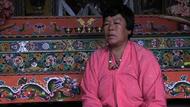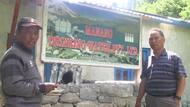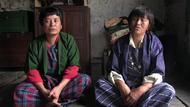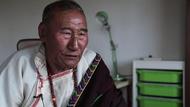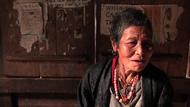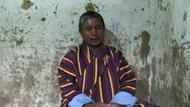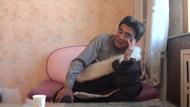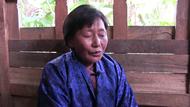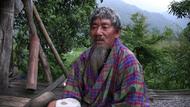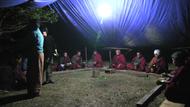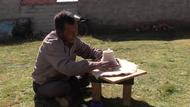Video Overview
A monk gives a brief history of the Kumbum and Pelkhor Chödé Monastery in Gyantse.
- Tsang
- Gyantsé Pelkhor Chödé
- Gyantsé Kumbum
- ཚེ་རིང་རྒྱལ་པོའོང་རེད།Right.
- སྐུ་ཞབས་ལགསའོ། ལགས་ཟེ་འེ། ང་ཚོའི་གཙུག་ལག་ཁང་འདི་ཆིག་སྟོང་བཞི་བརྒྱ་བཅོ་བརྒྱད་༼༡༤༡༨༽ལོར་ཕྱག་བཏབ་པ་རེད།Okay, our temple was built in 1418.
- སྐུ་ཞབས་ལགསད་དགོན་པ་འདིའི་གཙོ་བོ་འདི། ཨན། བཞངས་༼བཞེངས་༽སྟངས་དེ་དཔའ་༼དཔལ་༽འཁོར་བདེམ་༼བདེ་༽མཆོག་ཡོའོ་རེད་ཨཱ། བདེམ་༼བདེ་༽མཆོག་དཀྱིལ་འཁོར་ལུགས་བྱས་བཞངས་༼བཞེངས་༽བཞག་པ་དེ་འདྲས་ཅིག་རེད། ཆིག་སྟོང་བཞི་བརྒྱ་བཅོ་བརྒྱད་༼༡༤༡༨༽ལོར།This temple was built based on the tradition of the Cakrasamvara mandala in 1418. You know Cakrasamvara, right?
- སྐུ་ཞབས་ལགསཨན། ད་དགོན་པའི་ནང་ལོགས་ལ་གཙོ་བོ་རྟེན་གཙོ་ནི་ཇོ་བོ་རིན་པོ་ཆེས་གཙོ་བོ་བྱས་པའི་དེ་ནི་ལྷ་ཁང་དགུ་ཙ་༼ཙམ་༽གཅིག་ཡོའོ་རེད། ད་དེ་ཚོའི་ནང་ལོགས་ལ་དགུ་ད་ལྟ་མ་ཙང་༼མ་གཞི་༽ནས། དགུ། གང་ག་༼ཚང་མ་༽ཡོའོ་རེད།Well, there are around nine temples, and the Jowo Rinpoche is the main sacred object of the temple. So, there are around nine in the temple. Everything is there.
- སྐུ་ཞབས་ལགསདེ་ནས་འདི་མཆོད་རྟེན་འདི་ནི་ཆིག་སྟོང་བཞི་བརྒྱ་ཉི་ཤུ་རྩ་བདུན་༼1427 ༽ནང་ལོགས་ལ་བཞངས་༼བཞེངས་༽པ་རེད། ད་འདི་གཙོ་བོ་༼ཚོའི་༽ནང་ལོགས་ལ་ལྷ་ཁང་འདི་ལ་ལྷ་ཁང་བདུན་ཅུ་དོན་བདུན་༼77 ༽ཡོའོ་རེད། ལྷ་ཁང་། ལྷ་ཁང་བདུན་ཅུ་བདུན་བདུན་༼77 ༽བྱས།This temple was built in 1437. There are 77 temples in this main temple. There are 77 temples.
- སྐུ་ཞབས་ལགསདེ་ནས་འདི་ག་རེ་ཟ། ཨན།ལྷ་ཁང་ནང་ལོགས་ལ་སྐུ་འདི་གས་དེ་ནས་བླ་མ་ཡི་དམ། བྱས་ཙང་འདི་འདི་རེད་པཱ་ད། ཨན། རྒྱུད་སྡེ་བཞི། བྱ་རྒྱུད། སྤྱོད་རྒྱུད། རྣལ་འབྱོར་རྒྱུད། རྣལ་འབྱོར་བླ་མེད་རྒྱུད་བྱས་ནི་འདུག་བྱས་ནི་འདུག་ཕྱིན་ཡོའོ་རེད།The statues in the temples are lamas and deities, what do you say, umm, belonging to the four sets of Tantra-Action Tantra, Performance Tantra, Yoga Tantra, and the Highest Yoga Tantra.
- སྐུ་ཞབས་ལགསད་ང་ཚོའི་རི་མོ་འདི་དེ་ཞག་༼དེང་སང་༽ད། ཏས་ཙ་༼ཙམ་༽ཅིག་གིས་ག་རེ་ཟེར་དགོས་རེད། ཨན། ད། ཡན་ཅིའུ་༼རྒྱ་ནག་སྐད་དེ་བོད་སྐད་ལ་ཞིབ་འཇུག་ཟེར་༽བྱེད་ངན་༼མཁན་༽ད། རྒྱ་ནག་བློ་མཐུན་དེ་ཚོས་བལྟས་ཙ་༼ཙམ་༽དེ་ཚོས་བྱེད་སོང་ན་མངའ་རིས་ཀྱི་བཀྲ་ད་ཡོའོ་རེད་ཨཱ། བཀྲ་དའི་ལུགས་དེ་ཚོ་དང་འདི་ཚོ་འདྲ་པོ་གཅིག་འདུག་ཟེར་གྱི་འདུག།Chinese scholars who do research say that the illustrations of the temples are similar to that of the Trada in Ngari region. They say that they are similar to the Trada tradition.
- སྐུ་ཞབས་ལགསད་ང་ཚོའི་རང་ལྟ་དགོན་པ་རང་གི་ད་ནི་ད་ལྟ། ཨན། སྔན་༼སྔོན་༽མའི་གྱི་ད་དགོན་པའི་ཆ་ཚང་གི་མིའི་༼ཆ་ཚང་ཁོ་རང་གི་༽ལོ་རྒྱུས་གཅིག་ཡོད་ད་ཡོད་ཀྱི་རེད་དེ། ད་ལྟ་ད་ལྟའི་ཆ་ལ་ད་གང་ག་༼ཚང་མ་༽དེ་མིན་འདུག་ག་རེ་ཟེར་དགོས་རེད། ལོ་རྒྱུས་ཆ་ཚང་དེ་མིན་འདུག།It is possible that there once existed the whole history of the temple, but it does not exist any more.
- སྐུ་ཞབས་ལགསད་ལྟ་ཆིག་སྟོང་བཞི་བརྒྱ་བཅོ་བརྒྱད་༼༡༤༡༨༽ལོར་ཟེར་ཡས་འདི་ང་ཚོས་ད་དགོན་པའི་གྱི་སྔན་༼སྔོན་༽མའི་གྱི་ལོ་རྒྱུས་བསྡུ་རུབ་བྱས་པ་འདི་འདྲས་གཅིག་གི་ལོ་རྒྱུས་ནང་ལོགས་ལ་ཆིག་སྟོང་བཞི་བརྒྱ་བཅོ་བརྒྱད་༼༡༤༡༨༽དོན་ཡོང་གི་འདུག་མ་གཞི། གཞན་ད་ལྟའི་ཆ་ལ་ཁ་གསལ་ལ་འདི་འདྲས་ཧ་གོ་གི་མིན་འདུག།The year 1418 is something that comes out from the collections of some early history books of the temple. Other than that, we don't know it clearly.
- སྐུ་ཞབས་ལགསགཞན་ཕྱི་རྒྱལ་དང་ང་ཚོའི་བར་༼དབར་༽ང་ཚོ་རང་གི་ངོས་ནས་ཆ་བཞག་ནའི་ཨན་ད་དེ་རིང་དེང་དུས་ལྡེབས་རིས་ནང་ཅུའི་༼འདི་ཚོའི་༽རྒྱག་ལུགས་དང་བྱས་ནི་ཅིག་སྡུར་ཡོང་དུས་ཙ་༼ཙམ་༽ནས། ང་ཚོའི་དགོན་པ་འདི་ཆིག་སྟོང་བཞི་བརྒྱའི་སྔན་༼སྔོན་༽ལ་མེད་ད་༼དམ་༽བསམ་བསམ་གཅིག་འདུག།According to the western and our perspectives, it seems like our temple is pre-1400 because of the way the murals were made and the comparisons that were made between the murals.
- སྐུ་ཞབས་ལགསག་རེ་རེད་ཟེར་ན། ཆིག་སྟོང་བཞི་བརྒྱའི་སྔན་༼སྔོན་༽ལ་མེད་ད་༼དམ་༽བསམ་བསམ་རྒྱུམ་༼རྒྱུ་༽མཚན་དེ་ག་རེ་རེད་ཟེར་ན། བཀྲ་ཤིས་ལྷུན་པོ་དང་ང་ཚོའི་དགོན་པའི་བར་ད་༼དབར་༽ལ་ལོ་རྒྱུས་ཞེ་དྲག་གི་ད་ཅིག་རིང་གི་༼པོ་༽འདི་འདྲས་ཀྱི་ཐག་རིང་པོ་ཡོའོ་མ་རེད། ཁོ་ཉེ་པོ་བཟོ་འདྲའི་ཅིག་རེད་པཱ། ཉེ་པོ་བཟོ་འདྲའི་ཅིག་ཡིན་ཙ་༼ཙམ་༽ནས་ང་ཚོའི་དགོན་པའི་ལྡེབས་རིས་འདིའི་ལུགས་འདི་ཉེ་པོ་ཡིན་དུས་ཙ་༼ཙམ་༽ནས། ད།མི་ཐོག་ཕྱིན་ཡོའོ་མ་རེད། ལོ་ལྔ་དྲུག་དྲུག་བདུན་གྱི་སྐད་ཆ་རེད།The reason why we think it is pre-1400 is because our history and the history of Tashi Lhunpo are not that far away; they are quite close. Since mural tradition of our temple is close to the history of Tashi Lhunpo, it had not even been one generation. The gap between the two was a matter of 5, 6, or 7 years.
- སྐུ་ཞབས་ལགསད་དེ་འདྲས་ཡིན་དུས་ཙ་༼ཙམ་༽ནས་ང་ཚོའི་འདིའི་ལྡེབས་རིས་འདི་ཆགས་ཚུལ་འདི་སྤྱིར་ན་ལོ་རྒྱུས་བཟོ་འདྲའི་འདི་བཀྲ་ཤིས་ལྷུན་པོ་ལས་འདས་གོང་བཟོ་འདྲའི་གཅིག་ཡོའོ་རེད་པཱ། དེ་མིན་འདུག་བཀྲ་ཤིས་ལྷུན་པོ་ལ།Because of that the history or the mural tradition of our temple should go beyond Tashi Lhunpo's, but it is not the case.
- ཚེ་རིང་རྒྱལ་པོཨའ་ལས།I see.
- སྐུ་ཞབས་ལགསདེ་ནི་ང་ཚོའི་དགོན་པ་འདིའི་ནང་ལོགས་ལ་ལྡེབས་རིས་བཞངས་༼བཞེངས་༽ཡས་འདི་ཚོ་ཨུམ་༼བསྡུས་༽བྱས་ལྷ་རྩེ་དང་དེ་འདྲས་རིགས་ནས་མང་པོ་ཡོའོ་རེད། ད། དེ་འདྲས་ཡིན་དུས་ཙ་༼ཙམ་༽ནས་དེ་ནི་བཀྲ་ཤིས་ལྷུན་པོ་ལྷ་རྩེ་དང་ཁོ་ཚོ་ཐག་ཉེ་པོ་ཡིན་དུས་ཙ་༼ཙམ་༽ནས་དེ་ཚོ་ལྡེབས་རིས་འདི་དེའི་སྔོན་ནས་སྡུར་རར་༼བར་༽ཡིན་ན་ལོ་རྒྱུས་འདི་ཏིག་ཙ་༼ཙམ་༽ཏག་ཏག་བསྡད་ཨ་ཡོང་བསམ་བསམ་འདི་འདྲས་ཅིག་འདུག མ་གཞི་གཞན་ད་ང་ཚོ་ལ་ད་ལྟ་ང་ཚོའི་མོན་༼ཨན་༽དགོན་པའི་གྱི་དམངས་བདག་རེད་གྲྭ་པ་གང་ག་༼ཚང་མ་༽གི་ད་ཅིག་ལོ་རྒྱུས་འདི་རུབ་རུབ་བྱེད་ཡས་འཆར་གཞི་ཡོའོ་རེད་དེའི་༼ཡོད་ན་ཡང་༽ད་འདི་ཚོ་གང་ག་༼ཚང་མ་༽ཆ་ཚང་བྱེད་ཐུབ་ཀྱི་མིན་འདུག།There are many mural painters from Lhatse, etc. at our temple. So, Lhatse and Tashi Lhunpo are close by. Becuase of that, if we compared the two mural paintings I don't think the traditional history would hold. All of us, the monks and the {note: i don't know what 'dmangs bdag' means.} have plan to collect information about the history of the temple, but we can't do it all.
- སྐུ་ཞབས་ལགསད་དེ་གང་ལྟར་ཁ་ཙ།༼ཁ་སྔོན།༽ ཁེ་ཙང་སྔན་༼ཁ་སང་སྔོན་༽ལའི་ཞེ་དྲག་གི་ཁོ་མང་པོ་ཟེ་མེད་པ་བྱས། དེ་རིང་ཁ་སང་ནས་བྱས་ན་ཆ་རྐྱེན་གང་ནས་ཡིན་ནའི་༼གང་ནས་ཡིན་ཀྱང་༽འདང་གི་མ་རེད་པཱ། འདང་གི་མེད་དུས་ཙ་༼ཙམ་༽ནས་དཔར་འདི་འདྲས་འི་༼འདི་འདྲས་ཡང་༽ཞེ་དྲག་གི་བསྒྲུབ་མ་ཐུབ་པ་བྱས་དེ་ནི་ཁོ་དཔེ་ཆ་དེ་མང་པོ་མིན་འདུག། ལག། ད་ང་ཚོས་ད་ལྟ་ཡོད་པ་འདིའི་༼འདི་ཡང་༽ལག་བཤུས་བརྒྱབ་པ་འདི་རེད།We did not have enough facilities in the past, and we still do not have enough facilities these days. Because of the insufficient facilities, we have not been able to collect a lot of books. Furtheremore, there are not that many books also. The books that we have here are hand-copied.
- ཚེ་རིང་རྒྱལ་པོལགས་སོ་ལགས་སོ།I see. Thanks.
- སྐུ་ཞབས་ལགསའདི་དཔེ་ཆ་གཅིག་ལས་བསྡད་མིན་འདུག། ཁོས་འི་༼ཁོ་ཡང་འམ་ཡང་ན་འདི་ཡང་༽ང་ཚོའི་འདི་ལ་རང་སྐྱོང་ལྗོངས་ཀྱི་དེ་སྔོན་རིག་དངོས་ཚོགས་ཆུང་གིས་འདི་ལ་ནོར་བུ་གླིང་ག་ལ་འདི་བྱེད་པའི་ཁ་ཐུག་༼སྐབས་༽ལ་ནོར་བུ་གླིང་ག་ལ་འདི་ཡོའོ་རེད་བྱས་འདི་རྩ་བ་འདི་འདྲས་ལ་ཅིག་༼འདི་འདྲས་ཅིག་༽ང་ཚོའི་དགོན་པས་གཡས་༼གཡར་༽བྱས་དེ་བཤུས་པ་རེད།There was only one book. The Culture and Resource office {note: check the translation. depending on what the office is, it could also be spelled 'rigs dngos'} of the Tibetan Autonomous Region told us that this book was at Norbulingka when they were doing this at Norbulingka. Our monastery borrowed the original copy and made a copy of it.
- སྐུ་ཞབས་ལགསདེ་ནི་སྔན་༼སྔོན་༽ཆད་བྱས་ན་ང་ཚོའི་དགོན་པ་འདིའི་ནང་ལོགས་ལ་ལྷ་ཁང་བཅུ་དྲུག་ཡོའོ་རེད། གྲྭ་ཚང་བཅུ་དྲུག། ད། ད་ལྟའི་ཆ་ལ་བྱས་ན་གྲྭ་ཚང་འདི་ལས་ཡོའོ་མ་རེད། གཉིས་ལས། རྒྱབ་ལོགས་འདི་ལ་འདི་ན་ས་སྐྱཱ་གི་གུར་པ་ཟེར་ངན་༼མཁན་༽འདི་དང་། འདིའི་སྟེང་འདི་རི་ལྡེབས་འདི་ཞ་ལུ་བུ་ལུགས་སམ་༼འམ་༽བུ་སྟོན་ལུགས། ང་ཚོའི་འདི་ན་༼འདིའི་ནང་༽གྲུབ་མཐའ་ཁག་ཅིག་གསུམ་ཡོའོ་རེད། དགེ་ལུགས་བྱས། ས་སྐྱ་བྱས། བུ་ལུགས་བྱས།Previously our monastery had sixteen temples or sixteen monasteries. Nowadays there are only two monasteries. The Sakya monastery called Gurpa is behind this. And, there is a monastery associated with Zalu, or Bu tradition or Buton tradition on this hill. There are three sects here: Geluk, Sakya, and Bu tradition.
- སྐུ་ཞབས་ལགསདེ་ནས་ང་ཚོའི་སྔན་༼སྔོན་༽མ་བྱས་ན་གྲྭ་ཚང་བཅུ་དྲུག་ཡོད་པ་དེའི་ནང་ལོགས་ནས་དགེ་ལུགས་གྲྭ་ཚང་བརྒྱད་དང་། ཁོ་གཉིས་ཀྱི་གྲྭ་ཚང་བུ་ལུགས་བཞི་དང་ས་ལུགས་བཞི་བྱས་ནི་བཅུ་དྲུག་འདུག་ཟེ་རེད། དེ་ནས་ང་ཚོའི་མཆེད་༼ཆོས་༽གྲྭ་བཞི་ཟེ། གུར་པ་དང་། རི་ལྡེབས། རྩོལ་བ། ཞི་གནས་ཟེ་དགེ་ལུགས་ནང་ནས་ཆེ་བ་གཉིས་དང་ཁོ་གཉིས་ལ་རེ་རེ་ཟེ་བྱས་ནི་བཞི་འདུག་ཟེ་ཡོའོ་རེད།Among the sixteen monasteries that we had previously, eight of them were Geluk and the other two had four each. And there are four debate centres: Gurpa, Ridep, Tsolwa, and Zhinas. Geluk had two debate centres and the other two had one each.
- སྐུ་ཞབས་ལགསད་ད་ལྟའི་ཆ་ལ་ང་ཚོའི་དགེ་ལུགས་འདི་ལ་ད་གཅིག་ག་རེ་ཟེར་དགོས་རེད་ང་ཚོའི་ངོས་ནས་གྲྭ་པ་དམངས་ཀྱི་རེ་བ་རེད་གང་གའི་༼ཚང་མའི་༽ངོས་ནས་ཆ་བཞག་ན་ད་ང་ཚོ་འདི་ཆ་ཚང་བ་ཅིག། ག་རེ་རེད་ཟེར་ན་གཅིག་ནས་ད་གྲུབ་མཐའ་གསུམ་ཡོའོ་རེད་བྱས་པ་རེད་པཱ། གྲུབ་མཐའ་གསུམ་འདི་ད་ཆ་ཚང་བྱུང་བ་ཡིན་ན་ང་ཚོ་ཅིག། ཨན་སྤྱིར་ང་ཚོའི་མི་དམངས་ལ་ཕར་བཤད་པ་ཡིན་ནའི་༼ཡིན་ན་ཡང་༽ཁོ་སྤྱིར་རྒྱལ་སྤྱི་རྒྱལ་ནང་གི་གང་འདྲས་གཅིག་གི་ཐོག་ལ་ང་ཚོས་འགྲེལ་བཤད་བརྒྱབ་པ་ཡིན་ནའི་ཁོ་ང་ཚོ་གྲུབ་མཐའ་གསུམ་པོ་འདི་འདྲ་འདི་འདྲ་རེད་ཟེར་ཡས་བཟོ་འདྲའི་ཅིག གཞན་ད་ལྟའི་ཆ་ལ་གྲྭ་ཚང་གཉིས་ཡོད་པ་བྱས་གཅིག་ད་ལྟ་༼དེང་ན་༽མེད་པ་རེད་པཱ། བྱས་ནི་འདུག་ཟེ་རེད།As for the Gelug tradtion at this present moment, all the monks hope to have the complete set of schools. Because on the one hand we say that there are three schools, right? If we had all three schools, we could say that these are what the three schools are if we had to explain to the public or to the world. Right now we have two monasteries, one no longer exists.
- ཚེ་རིང་རྒྱལ་པོལགས། ལགས། ལགས།Right, right.
- སྐུ་ཞབས་ལགསད་སྔམ་༼སྔོན༽ཆད་བྱས་ན། གྲྭ་པ་ཉིས་སྟོང་ལྔ་བརྒྱ་ཙ་༼ཙམ་༽འདུག།Previously there were around 2500 monks.
- ཚེ་རིང་རྒྱལ་པོལགས་སོ།I see.
- སྐུ་ཞབས་ལགསད། ད་ལྟ་གྲྭ་ཚབ་བརྒྱ་ཅུ་ལྷག་ཙ་༼ཙམ་༽ཅིག་ཡོའོ་རེད།Now there are little over 80 monks.
- ཚེ་རིང་རྒྱལ་པོལགས་སོ།I see.
- སྐུ་ཞབས་ལགསའོ་གཙོ་བོ་རགས་བསྡུས་བཟོ་འདྲའི་འདི་ད་འདི་འདྲས་ཅིག་རེད། ཞུ་ཡས་གཞན་དག་གང་།This is a brief story. There is nothing esle to say.
- ཚེ་རིང་རྒྱལ་པོརེད། རེད། རེད། འདི་ཨན། སྐུ་འབུམ་ནང་ལོགས་ཀྱི་ལྡེབས་རིས་འདི་གས་གྲུབ་མཐའ་ཆ་ཚང་ཡོའོ་རེད་རེད་པཱ།Yes, indeed. So, are there mural paintings belonging to all schools at Kubum?
- སྐུ་ཞབས་ལགསགྲུབ་མཐའ་བྱས་ནའི་ད་འདི། ཨན།Well, whether you call it school or not...
- ཚེ་རིང་རྒྱལ་པོབཀའ་གདམས་པ་ནས་བྱས་བྱས་ཆ་ཚང་།All beginning with that of Kadam tradtion?
- སྐུ་ཞབས་ལགསའོའོ།༼རེད།༽ བཀའ་གདམས་པ་ནས་བྱས་ཆ་ཚང་ཡོའོ་རེད།Yes, they have everything starting from the Kadam tradition.
- ཚེ་རིང་རྒྱལ་པོརྙིང་མ་ཡའི་༼རྙིང་མ་ཡང་༽ཡོའོ་རེད་པཱ།Do they also have Nyingma's mural paintings?
- སྐུ་ཞབས་ལགསརྙིང་མ་ཡའི་༼མ་ཡང་༽ཡོའོ་རེད། ཆ་ཚང་ཡོའོ་རེད།They have Nyingma's mural paintings also; they have everything.
- ཚེ་རིང་རྒྱལ་པོལགས་ཟེ། ལགས་ཟེ། རེད། རེད།Thanks. I see.
- སྐུ་ཞབས་ལགསཆ་ཚང་ཡོའོ་རེད། ད་འདི་ཨན། ག་རེ་ཟེར་དགོས་རེད། ད་ཅིག་དགེ་ལུགས་པ་འདི་སྔོན་མ་ཞེ་དྲག་སྔན་༼སྔོན་༽ལ་ར་བུ་༼འདི་འདྲས་༽དར་མི་འདུག།They have everything. Well, Geluk tradition was not that prevalent in the olden times.
- ཚེ་རིང་རྒྱལ་པོལགས།Right.
- སྐུ་ཞབས་ལགསསྔན་༼སྔོན་༽ལ་དར་མེད་པ་བྱས། ད་རྗེས་ལ་ང་ཚོའི་དགོན་པ་འདི་ཕྱག་བཏབ་པའི་ཁ་ཐུག་༼སྐབས་སུ་༽ལ། ད་མཁས་གྲུབ་རིན་པོ་ཆེ་བྱུང་། ད་དེ་ནས་དེའི་རྗེས་ནས་མར་དགེ་ལུགས་བྱུང་བ་རེད་པཱ།It was not prevelant in the olden times. Later, Khedup Rinpoche came during the time of the construction of our monastery. Geluk tradition came after that.
- ཚེ་རིང་རྒྱལ་པོལགས་རེད།Right.
- སྐུ་ཞབས་ལགསབྱས་ནས་ད་འདིའི་ནང་ལོགས་ལ་དགེ་ལུགས་ཀྱི་སྐུ་འདི་འདྲས་ག་རེ་ཟེར་དགོས་རེད་ལྡེབས་རིས་འདི་འདྲས་ཡོའོ་རེད་མ་གཞི། སྐུ་རང་འདི་ཡོའོ་མ་རེད།So, there are only Geluk's mural paintings here. There are not any Geluk's statues in it at present. {note: we could may be move the first of the next section over here.}
- ཚེ་རིང་རྒྱལ་པོལགས་ཟེ། ལགས་ཟེ།I see.
- སྐུ་ཞབས་ལགསད་ལྟའི་ཆ་ལ། གཞན་ས་དགེ་རྙིང་གསུམ་གང་ག་༼ཚང་མ་༽ཡོའོ་རེད། ད་འདིའི་ནང་ལོགས་ལ། ས་དགེ་རྙིང་གསུམ་ཇོ་ནང་གང་ག་༼ཚང་མ་༽ད་གང་ལྟར་བོད་ཀྱི་ནང་པའི་ཆོས་མ་ཡིན་ན་མ་གཞི་ཡིན་ཚད་ཁོ་རང་གང་ག་༼ཚང་མ་༽དེ་ན་བླ་རྒྱུད་ཡོའོ་རེད།Other than that, we have all three traditions of Sakya, Geluk, and Nyingma in this monastery. All lineage lamas of all Tibetan Buddhist schools such as Sakya, Geluk, Nyingma, Jonang, and so forth are in it.
- སྐུ་ཞབས་ལགསདེ་ནས་བླ་རྒྱུད་འདི་མ་ཟད་ཀྱི་འདི་ནང་ལོགས་ལ་ལྡེབས་རིས་ལ་ད། ད་ལྟ་ང་ཚོས་འེ་༼ང་ཚོས་ཀྱང་༽ཞིབ་ཚགས་པ་འདི་འདྲས་དང་འདི་འདྲས་ཀྱིས་ཉམས་འཇུག་༼ཞིབ་འཇུག་༽བྱེད་རྒྱུ་མ་བྱུང་མ་གཞི་ཕྱི་རྒྱལ་འདི་འདྲས་ཀྱིས་ཏས་ཙ་༼ཙམ་༽ཧ་གོ་གི་འདུག་ག། ག་རེ་རེད་ཟེར་ན། བོད་ཀྱི་རྒྱལ་རབས་ཆ་ཚང་རྒྱལ་པོ་ཆ་ཚང་འདུག་ག་འདིའི་ནང་ལོགས་ལ་གང་ག་༼ཚང་མ་༽བྲིས་བཞག།In addition to the mural paintings of the lineage lamas, there are all the Tibetan kings written on the wall. We have not done any research into it, but some westerners know a little bit about it.
- ཚེ་རིང་རྒྱལ་པོལགས་ཟེ། ལགས་ཟེ།I see.
- སྐུ་ཞབས་ལགསའདི་འདྲས་ཡོའོ་རེད། ད། ང་ཚོའི་དེའི་ལོ་རྒྱུས་བཟོ་འདྲའི་འདི་ད་འདི། ད། འདི་ཡིན་ན་ཅིག་ཁོ་ལྡེབས་རིས་དེ་རིན་ཐང་བྲལ་བ་ཅིག་བྱས། ད། དེ་རིང་ཁ་སང་ཉམས་གསོ་བྱེད་མཁན་ཡིན་ནའི་༼ཡིན་ན་ཡང་༽བྱེད་ཁག་པོའི་བཟོ་འདྲའི་ཅིག་དང་ཅིག་ཁོ་འདུག་གཱ།This is the story of our mural paintings. In any case, these mural paintings are priceless. It is quite difficult to restore these nowadays.
- ཚེ་རིང་རྒྱལ་པོལགས་རེད།Indeed.
- སྐུ་ཞབས་ལགསསྐྱོན་གཙོ་བོ་དེ། དེ་འདི་འདྲས་གཅིག་འདུག།This is the main problem.
- ཚེ་རིང་རྒྱལ་པོརེད། རེད། རེད། རེད། འདི་ཨན། སྐུ་འབུམ་དང་གཙུག་ལག་ཁང་འདི་གཉིས་གྲུབ་མཐའ་ཆ་རེད། རེད་པཱ།Right, right. So, Kubum and the Temple share the same school, right?
- སྐུ་ཞབས་ལགསང་ཚོའི་གཙུག་ལག་ཁང་འདི་ང་ཚོ་ད་སྔར་བྱས་ན་དགེ་ལུགས་གང་ག་༼ཚང་མ་༽དང་གྲྭ་ཚང་བཅུ་དྲུག་ཡོའོ་རེད་པཱ། གྲྭ་ཚང་བཅུ་དྲུག་གྲྭ་པ་གང་ག་གི་༼ཚང་མའི་༽ཚོགས་ཚོགས་ས་དེ་གཙོ་བོ་ཁོ་རེད། ད་འདུ་ཁང་གཙོ་བོ་ཁོ། གཙོ་བོ་གི་བྱས། ད་འདི་གོ་༼གས་༽གཉིས་གཞན་ཁ་༼མ་གཞི་༽ད་ང་ཚོའི་དགོན་པ་གྱི་༼དགོན་པའི་༽ཁུངས་རེད་པཱ།Remember that the Geluk monastery had sixteen monasteries previously. The Temple was the main prayer hall where the monks of the sixteen monasteries did their prayers. But it was still a part of our monastery.
- ཚེ་རིང་རྒྱལ་པོལགས་རེད།Right.
- སྐུ་ཞབས་ལགསད་འདི་ཕར་ཕྱོགས་འདི་གྲྭ་ཚང་ཅིག་འདུ་ཁང་དང་ལྷ་ཁང་ཆབས་གཅིག་བྱས། འདི་མཆོད་རྟེན་ཁོ་རང་དམིགས་བསལ་དང་། མཆོད་རྟེན་ད་འདི་ང་ཚོའི་འདི་ལ་བཤད་ཚུལ་ཁག་གཅིག་གིས་ཟེར་ན་རྒྱང་རྩེ་དཔའ་༼དཔལ་༽འཁོར་མཆོད་རྟེན་འདི་ལ་ཆོས་རྒྱལ་གྱི་ཡིན་ནས་མར་རྫོང་ནས་ག་རེ་ཟེར་དགོས་རེད་ཆུའི་གཏིང་ལ་བྱེ་མ་ལ་དེ་ནི་མ་རུ་ཆུ་འདོན་ཡས་ཀྱི་ཆུ་གཟར་བྱས་དེའི་སྒང་ལ་བྱེ་མ་བཙགས་༼བརྩེགས༽། ཨ་ནི། བྱེ་མ་འདི་ལ་བརྟེན་ནས་མཆོད་རྟེན་འདི་འདྲས་ཀྱི་བཟོ་ལྟ་བཞངས་༼བཞེངས་༽བ་རེད་ཟེར་ཡས་གཅིག་དང་གཅིག་འདུག་སྟེ་༼ན་ཡང་༽། ད་འདི་ཚོ་དོན་ག་གི་ཡིན་མིན་ང་ཚོས་ད་དེ་ཞེ་དྲག་གི་འདི་བྱེད་ཡས་ཡོའོ་མ་རེད།The over there is both a prayer hall and a temple of the monastery. This is a unique stupa. One account says that this Palkhor stupa was built by piling up sands deep in the water when the religious king was coming down from the district. {note: check the translation and the transcript.} And the shape of this stupa was built from the sands. However, we don't have to pay that much attention to such account.
- ཚེ་རིང་རྒྱལ་པོརེད། རེད། རེད། རེད། ལགས་ཟེ། འདི་༼འདིའི་༽རྟེན་གཙོ་བོ་ག་རེ་ཡིན་ན་འདི་གཉིས།Yes, indeed. Thanks. What is the main statue of these two?
- སྐུ་ཞབས་ལགསརྟེན་འདིའི་འདི་གཙོ་བོ་འདི་སྟོན་པ་རེད། ཇོ་བོ། ད། ང་ཚོས་རྒྱལ་རྩེའི་ཇོ་བོ་ཟེར་གྱི་རེད་པཱ།The Buddha is the main statue of this temple. We also call it Gyantse Jowo.
- ཚེ་རིང་རྒྱལ་པོརེད། རེད། རེད། རེད།Right, right.
- སྐུ་ཞབས་ལགསའོ། ཇོ་བོ་འདི་ད་ཕལ་ཆེར་ང་རང་ཚོའི་ངོས་ནས་ཆ་བཞག་ན་རྒྱ་གར་གྱི་མཱ་ཧ་བུ་ཏི་ཟེར་གྱི་འདུག་ག། རྒྱ་གར་གྱི་གང་ལྟར་ལྷ་ཁང་གཅིག་གི་ནང་ལོགས་ཀྱི་སྐུ་དང་ང་ཚོའི་འདི་འདྲ་འདྲ་ཡིན་ཟེ་༼ཟེར་༽སྐུ་ཚད།From our perspective, the height of this statue is same as the one in the Mahabodhi temple in India.
- ཚེ་རིང་རྒྱལ་པོལགས་ཟེ། ལགས་ཟེ།Thanks.
- སྐུ་ཞབས་ལགསད་ཇོ་བོ་ཇོ་བོ་ངོས་ནས་ཆ་བཞག་ན་སྐུ་ཚད་ཆེན་པོ་འདི་ག་ཙ་༼ཙམ་༽ཅིག་བྱས་པ། རྩ་བའི་བྱས་ན། ད། བོད་ལ། ད། བོད་ད་མ་ཚད་༼ཟད་༽འཛམ་བུ་གླིང་ལའི་༼ལ་ཡང་༽ཡོད་ཀྱི་མ་རེད། ཇོ་བོ།Generally speaking, such a size of the statue of Jowo probably does not exist in the whole world, let alone in Tibet.
- ཚེ་རིང་རྒྱལ་པོལགས། ལགས། ལགས།Indeed.
- སྐུ་ཞབས་ལགསཇོ་བོ་རེད་པཱ།This is Jowo.
- ཚེ་རིང་རྒྱལ་པོལགས་ཟེ།Right.
- སྐུ་ཞབས་ལགསགཞན་ད་སྟོན་པ་ད་ཡོའོ་རེད་པཱ། ད། མིའི་ཇོ་བོ་དབུ་པྲོག་ཞུས་མ་ཞུས་ཀྱི་སྐད་ཆ་རེད་པཱ།Yes, there are many big statues of the Buddha. And, the difference between the statue of the Buddha and the statue of Jowo lies in whether one has the top or not on their heads. [Jowo has the top.]
- ཚེ་རིང་རྒྱལ་པོལགས་རེད། ལགས་རེད།Right, right.
- སྐུ་ཞབས་ལགསསྟོན་པ་ཡོའོ་རེད་དའི་༼ཡོད་ཀྱང་༽ཇོ་བོ་ང་ཚོའི་འདི་ལས་ཆེ་བ་ཡོའོ་མ་རེད།There are statues of the Buddha that are bigger, but there is no Jowo which is bigger than our's.
- ཚེ་རིང་རྒྱལ་པོལགས་ཟེ། ལགས་ཟེ།I see.
- སྐུ་ཞབས་ལགསདེ་ནི་འདིའི་ནང་ལོགས་ལའི་༼ལ་ཡང་༽སྟོན་པ་རེད། ཡང་འེ།There is a statue of the Buddha in this also.
- ཚེ་རིང་རྒྱལ་པོལགས་ཟེ། ལགས་ཟེ།I see.
- སྐུ་ཞབས་ལགསགཙོ་བོ་སྟོན་པ་བྱས། དེ་ནས་གཙོ་༼རྩེ་༽འདི་ལ་རྡོ་རྗེ་འཆང་བྱས། རྩེ་རུ།The main statue is the Buddha. And there is a statue of Vajrapani on the top.
- ཚེ་རིང་རྒྱལ་པོལགས་ཟེ། ལགས་ཟེ།I see.
- སྐུ་ཞབས་ལགསའོག་འདི་ལ་སྟོན་པ་བྱས།On the bottom is a statue of the Buddha.
- ཚེ་རིང་རྒྱལ་པོརེད། རེད། རེད། རེད།Thanks.
- སྐུ་ཞབས་ལགསལྷ་ཁང་འདིའི་ནང་ལོགས་ལ་ལྷ་ཁང་བདུན་ཅུ་དོན་བདུན་༼77 ༽ཡོའོ་རེད།There are 77 temples in this temple.
- ཚེ་རིང་རྒྱལ་པོལགས་ཟེ། ལགས་ཟེ།I see.
- སྐུ་ཞབས་ལགསསྐུ་འབུམ་ནང་ལོགས་ལ།Inside Kubum.
- ཚེ་རིང་རྒྱལ་པོརེད། རེད། ཕི་གའི་༼ཕ་གའི་༽ལྷ་ཁང་ག་ཚོད་ཡོད་ན།༼ནམ།༽How many temples are there over there?
- སྐུ་ཞབས་ལགསཕ་གའི་ལྷ་ཁང་བཅུ་གསུམ་ཙ་༼ཙམ་༽ཅིག་ཡོའོ་རེད། ཕ་གིའི་ནང་ལོགས་ལ།There are around 13 temples there.
- ཚེ་རིང་རྒྱལ་པོལགས་ཟེ། ལགས་ཟེ།I seee.
- སྐུ་ཞབས་ལགསལྷ་ཁང་བཅུ་གསུམ་ཙ་༼ཙམ་༽ཅིག་ཡོའོ་རེད།There are around 13 temples.
- ཚེ་རིང་རྒྱལ་པོརེད། རེད། རེད། ཕི་༼ཕ་༽གའི་ཐོག་རྩེག་༼རྩག་༽གཉིས་པ་དེ་ས་སྐྱའི་ལུགས་ཅིག་སྦྱར་རེད་པཱ། དཀྱིལ་འཁོར་ཅིག་བྱས།Thanks. The second story was based on the Sakya tradition, right? There is a mandala also, right?
- སྐུ་ཞབས་ལགསགཞོགས་འདི་ཚུར་ཕྱོགས་འདི་ས་སྐྱའི་ལམ་འབྲས་ཀྱི་ལུགས་བྱས་ནས་ད་ལམ་འབྲས་ནས་མར་རྡོ་རྗེ་འཆང་ནས་བུའུ་བ་པ་ལ་མར་བརྒྱུད། བུའུ་བ་པ་ནས་ས་སྐྱ་གང་ལྟར་གོང་མ་ལྔ་ལ་བརྒྱུད་ཡོང་བའི་ལོ་རྒྱུས་བྱས་ནི་འདུག་ཟེ་ཕྱིན་ཡོའོ་རེད་པཱ།The one on this side was built based on the Path and Fruit tradition of the Sakya School. There is a story that this tradition was tranmitted to the Five Sakya Masters by Virupa. And it was transmitted to Virupa by Vajrapani.
- ཚེ་རིང་རྒྱལ་པོལགས་རེད།Indeed.
- སྐུ་ཞབས་ལགསརྒྱ་གར་གྲུབ་ཆེན་བརྒྱད་ཅུ་འདུག་ཟེ་ཡོའོ་རེད།The Eightly Indian Mahasiddhas are here.
- ཚེ་རིང་རྒྱལ་པོརེད། རེད།I see.
- སྐུ་ཞབས་ལགསའདིའི་ཕར་ཕྱོགས་འདིའི་ནང་ལ་གནས་བརྟན་བཅུ་དྲུག་རེད། ད་གནས་བརྟན་བཅུ་དྲུག།The Sixteen Aryats are over there.
- ཚེ་རིང་རྒྱལ་པོཨ་ལས།I see.
- སྐུ་ཞབས་ལགསད་ང་ཚོའི་འདི་ལས་གནས་བརྟན་བཅུ་དྲུག་འདི་བཤད་སྲོལ་འདི་ཁག་གཉིས་ཡོའོ་རེད།We have two different accounts for these Sixteen Arhats.
- ཚེ་རིང་རྒྱལ་པོལགས། ལགས།I see.
- སྐུ་ཞབས་ལགསགཅིག་གིས་ཟེར་དུས་ཙ་༼ཙམ་༽ནས། ཨན། ཕྱི་ནང་གསང་གསུམ་གྱི་གནས་བརྟན་བཅུ་དྲུག་ཡོའོ་རེད་བྱས་པ་རེད།One says that there are external, internal, and secret forms of the Sixteen Arhats.
- ཚེ་རིང་རྒྱལ་པོལགས་ཟེ།I see.
- སྐུ་ཞབས་ལགསཕྱིའི་གནས་བརྟན་བཅུ་དྲུག་ག་རེ་ཡོའོ་རེད་ཟེར་ན། ལྕགས་རི་འདིའི་ནང་ལོགས་ལ་ལྕོག་ཡོའོ་རེད་པཱ། ལྕོག་བཅུ་དྲུག་ཡོའོ་རེད། ད་འདི།What are the external forms of the Sixteen Arhats? There are pinnacles inside those fences, okay. There are 18 of those pinnacles.
- ཚེ་རིང་རྒྱལ་པོཨ་ལས།I see.
- སྐུ་ཞབས་ལགསལྕོག་འདི་ནས། འདི་གནས་བརྟན་ཕྱིའི་གནས་བརྟན་བཅུ་དྲུག་མཚོན་ཚུལ་ཡིན་ཟེར་གྱི་ཡོའོ་རེད།These pinnacles symbolize the external forms of the Sixteen Arhats.
- ཚེ་རིང་རྒྱལ་པོལགས། ལགས།Thanks.
- སྐུ་ཞབས་ལགསབར་གྱི་གནས་བརྟན་བཅུ་དྲུག་འདི་བླ་གབ་བཅུ་དྲུག་འདི་གས་ཀྱིས་མཚོན་གྱི་ཡོའོ་རེད་ཟེར་གྱི་རེད།The Sixteen Intermediate Arhats are represented by these sixteen canopies.
- ཚེ་རིང་རྒྱལ་པོལགས་ཟེ། ལགས་ཟེ།Thanks.
- སྐུ་ཞབས་ལགསད་ནི་གསང་བའི་ཟེར་ན་ད་ག་རེ་རེད་ཟེར་ན་སྦུག་ན་བར་ན་ལམ། ལམ་འབྲས་ཁ་སྤྲོད་འདི་ནས་ཕར་ཕྱོགས་འདི་ན་གནས་བཅུ་ལྷ་ཁང་ཡོའོ་རེད་པཱ།The secret refers to the temple of the Sixteen Arhats that is located on the opposite side of the Fruit and Path. It is way inside.
- ཚེ་རིང་རྒྱལ་པོའོ་རེད་བ། འོ་རེད་བ།Indeed.
- སྐུ་ཞབས་ལགསགནས་བཅུ་འབྲེལ་བ་འདིས་འདུག་ཟེ་བཤད་སྲོལ་འདི་འདྲས་གཅིག་ཡོའོ་རེད།This is one interpretation of the connection with the Sixteen Arhats.
- ཚེ་རིང་རྒྱལ་པོལགས་སོ་ལགས་སོ། ཨ་ལས། འདི་སྔན་༼སྔོན་༽མ་བྱས་ན་ད་མཐོ་ཤོས་འདི་མཁན་པོ་བརྩི་གི་རེད། ག་རེ་བརྩི་གི་རེད། བླ་བྲང་ཡོའོ་རེད། གང་འདྲས་རེད།Thanks. Well, was it the abbot who was considered as the highest in the past? Who was considered as the highest? Was there a lama's residence? What was it like then?
- སྐུ་ཞབས་ལགསང་ཚོའི་འདི་ཀྱི་སྔན་༼སྔོན་༽མ་བྱས་ན་རྦད་དེ་ཅིག་བླ་བྲང་ཅིག་མཁན་པོ་འདི་ཕ་ནས་ག་རེ་ཟེར་དགོས་རེད་ས་གནས་སྲིད་གཞུང་ནས་ཚུར་བཏང་ཡོང་ས་རེད།It seems like the local government dispatched the abbot for us in the past.
- ཚེ་རིང་རྒྱལ་པོཨ་ལས། ག་ནས། འབྲས་སྤུངས་ནས་ཡིན་ན། སེ་ར་ནས།I see. From where? Were they from Drepung or Sera?
- སྐུ་ཞབས་ལགསད་འདི་ཕལ་ཆེར་ཁར་ཕ་ནས་རྩིས་དྲུང་འདི་འདྲས་ཡིན་ས་རེད། ད་གང་ལྟར་གང་ནས་གཏོང་གི་ཡོད་ད།༼ན།༽I think they were accountants from whereever they were sent.
- ཚེ་རིང་རྒྱལ་པོལགས་སོ།Thanks.
- སྐུ་ཞབས་ལགསརྩེ་ནས་རྩེ་དྲུང་འདི་འདྲས་གཏང་ཡོང་བྱས། དེ་ནི་འདི་ང་ཚོས་ཆོས་ཆོས་སྲིད་ཟུང་འབྲེལ་ཟེར་ཡས་འདི་ད་ང་ཚོའི་གཅིག་གི་གྲྭ་པ་འདིའི་མཁན་པོ་འདིས་ང་ཚོའི་ཆོས་ལུགས་འདི་འགན་འདི་གས་གང་ག་རྒྱང་རྩེ་རྫོང་། རྒྱང་རྩ་རྫོང་ཡོའོ་རེད་པཱ། རྒྱང་རྩེ་རྫོང་གི་འདིའི་འགན་འདི་འཁུར། དེ་ནི་འདིའི་སྒང་ལ་མགྲོན་གཉེར་འདིས་ང་ཚོ་རྒྱང་རྩེ་འདིའི་ཅིག་འཁུར་གྱི་ཡོད་ས་རེད།They sent accountants from Tse. And, the reason why it was called a unification of religious and political government was because the abbots would take all the responsibilities of the religious affairs, of the monastic affairs in the Jangtse district. You know Gyantse district, right? And it seems like the secretary would take the responsibility of the lay people in Gyantse.
- ཚེ་རིང་རྒྱལ་པོཨ་ལས།I see.
- སྐུ་ཞབས་ལགསམི་དམངས་དེ་གས་འདི།[The responsibility] of common people.
- ཚེ་རིང་རྒྱལ་པོརེད། རེད།Right, right.
- སྐུ་ཞབས་ལགསའོ་འདུག་ཟེ་རེད།This was the case.
- ཚེ་རིང་རྒྱལ་པོམཁན་པོ་བཞུགས་ས་འདི་རྫོང་ལ་བཞུགས་ཀྱི་ཡོའོ་རེད་བྱས་ན་རེད་པཱ།So, in that case, the abbot lived at the fort, right.
- སྐུ་ཞབས་ལགསམཁན་པོ་བཞུགས་ས་འདི་ཡིན་རྒྱུ་འདི་ང་ཚོའི་འདིའི་ནང་ལོགས་ལ་བླ་བྲང་ཡོའོ་རེད། བླ་བྲང་དེ་ལ་བཞུགས་ཀྱི་ཡོའོ་རེད།We have a lama's residence here. This is supposed to be the abbot's residence. He lives at the lama's residence.
- ཚེ་རིང་རྒྱལ་པོལགས། ལགས། ལགས། རེད། རེད། དེའི་གྲྭ་པའི་སྒྲིག་གཞི་བཟོ་འདྲའི་འདི་མཁན་པོའི་ཞུགས་གོ་༼རྗེས་སུ་༽ལ་དབུ་མཛད་དང་ཁོང་དཀོན་༼དཀོར་༽གཉེར་ཆ་ཚང་།I see. Thanks. What is the monastery's disciplinary system like? Do you have the chant master, care-taker of the monastery, etc. below the rank of the abbot?
- སྐུ་ཞབས་ལགསམཁན་པོའི་ཞུགས་གོ་༼རྗེས་སུ་༽དུས་ལ་ང་ཚོ། དཔེར་ན་ཆ་བཞག་ན་དགོན་པ་འདིའི་ནང་ལོགས་ལ་ཡང་འདི་འདྲས་ཡོའོ་རེད་པཱ། ག་རེ་ཟ། ཨན་དོ་གཉེར་ཟེ། དོ་དམ་ཡོའོ་རེད་པཱ། དོ་དམ། དོ་དམ་རིམ་པ་ཡོའོ་རེད། ད་དོ་དམ་རིམ་པ་བྱས་དེ་ནི་དེ་ནས་མར་རིམ་པ་རིམ་པར་གནས་ཡོད་ས་རེད།Below the rank of the abbot, we have, for instance, the level of management office at the monastery. And, there are many levels below it.
- སྐུ་ཞབས་ལགསདེ་ནི་གྲྭ་ཚང་སོ་སོ་ལ་ནི་དགོན་པ་སོ་སོ་ལ་གྲྭ་པ། འདི་ཡོའོ་རེད་པཱ། མཁན་པོ་ཡོའོ་རེད་པཱ།And each monastery has its own abbot.
- ཚེ་རིང་རྒྱལ་པོརེད། རེད། རེད།Right, right.
- སྐུ་ཞབས་ལགསམཁན་པོ་དབུ་མཛད་དགེ་བསྐོས་འདི་འདྲས་ཡོའོ་རེད་པཱ།They have the abbot, chant master, disciplinarian, etc.
- ཚེ་རིང་རྒྱལ་པོརེད། རེད། རེད། ཨ་ལས་ལས། རེད། རེད། གང་ག་༼ཚང་མ་༽ལོགས་འདིའི་འོག་ལ་རེད། རེད་པཱ།I see. Right, right. All of them are below this, right?
- སྐུ་ཞབས་ལགསའོ་རེད།Right.
- ཚེ་རིང་རྒྱལ་པོརེད། རེད། ཨ་ནི་འདི་ག་རེ་ཟེར་དགོས་རེད། སློབ་སྦྱོང་བྱེད་ཡས་འདི་གཙོ་ཆེ་ཤོས་བཤད་གྲྭ་དང་སྒྲུབ་གྲྭ་གཉིས་ཆ་༼ཀ་༽་ཡོད་ན།༼ནམ།༽Right, right. Well, as for the academic study, are there both debate school and practice school?
- སྐུ་ཞབས་ལགསའོ་བཤད། སྔན་༼སྔོན་༽མ་བྱས་ན་བཤད་སྒྲུབ་གཉིས་ཀ་ཡོའོ་རེད། ད། བཤད་སྒྲུབ་ཡོད་པས་མ་ཚད་ང་ཚོའི་འདི་ན་ཕོན་༼གྲངས་འབོར་༽ཆེན་པོ་ཡོའོ་རེད། ཕོན་ཆེན་པོ་ཡོའོ་རེད་རྒྱུམ་༼རྒྱུ་༽མཚན་ག་རེ་རེད་ཟེར་ན། དེ་རིང་ཁ་སང་གི་དགེ་བཤེས་ཀྱི་ད་གང་ལྟར་ང་ཚོ་ལྷ་རམས་པ་ཟེར་ན་ལྷ་ས་སྨོན་ལམ་ཚུགས་པའི་བཟོ་འདྲའི་འདི་ང་ཚོ་རྒྱང་རྩེར་སྨན་ལྷ་ཟེ་ཟླ་བ་ལྔ་པའི་ནང་ལོགས་ལ་འདི་རུ་ཚུགས་ཀྱི་ཡོའོ་རེད།Yes, we had both debate and practice schools in the past. Not only did we have the debate school, the number of participants was large also. The reason why we had a large number of participants was because we had this ceremony called Menlha in the fifth month of the Tibetan lunar calendar here in Gyantse just like the Lhasa Monlam ceremony during which the widely-known Geshe Lharam debates were held.
- ཚེ་རིང་རྒྱལ་པོལགས། ལགས།Thanks.
- སྐུ་ཞབས་ལགསའདུ་རུ་༼འདི་རུ་༽ཚུགས་ཡོད་དུས་ཙ་ནས་ང་ཚོའི་འདིའི་གི་ནང་ལོགས་ལ་དགོན་པ་མང་པོ་ནས་ཡོང་གི་ཡོའོ་རེད། ཞ་ལུ་ནས་ཡོང་གི་ཡོའོ་རེད། བཀྲ་ཤིས་ལྷུན་པོ་གཙོ་བོར་འགྱུར་པའི་བཀྲ་ཤིས་ལྷུན་པོ་ནས་རྒྱུགས་ཡོང་གི་ཡོའོ་རེད། དེ་ནས་ཨན་རྟ་ནག་ཕ་ནས་ཡང་དགོན་པ་དེ་ནས་ཡོང་གི་འདུག། དེ་ནས་ཨན་ཤང་དགའ་ལྡན་ཆོས་འཁོར་ཡོང་གི་འདུག། ཡར་འབྲོག་བསམ་འདུས་དགོན་ཡོང་གི་འདུག། དེ་ནས་དེ་འདྲ་གཅིག་ནས་ཡང་དེའི་ག་རེ་ཟ། ཨན། འུ་ཡུག་ངོས་ནས་དགོན་པ་ཆུང་ཆུང་གཅིག་ང་ཚོའི་དགོན་པ་འདི་རུ་ཡོང་དམ་བཅའ་ཡོང་། དགོན་པ་འདི་རུ་ཡོང་། དམ་བཅའ་བཞག ད་དེ་ནས་མིའི་དགེ་བཤེས་ཀྱི་མཚན་རྟགས་བཟོ་འདྲའི་འདི་ང་ཚོའི་དགོན་པ་འདི་ནས་སྤྲད། མར། དགོན་པ་འདི་ནས་སྤྲད་བྱས། དེ་ནས་ཁོང་ཚོ་དགོན་པ་ལ་སོ་སོ་ལོག་པ་ཡིན་ནའི་ཁོང་ཚོའི་ཐོབ་ཐང་བཟོ་འདྲའི་འདི་འདི་ནས་འདིའི་སྐབས་ལ་ཆ་བཞག་གི་འདུག་ག།Monks from many different monasteries would come during the ceremony here. Monks from Zhalu monastery would come. It was predominantly the monks from Tashi Lhunpo monastery who would come here. And the monks from the monastery in Tanak would come. And the monks from Shang Gaden Choekhor would come. And the monks from Yardrok Samdue monastery would come. And the monks from a small monastery somewhere in Huyok would come to this monastery for the thesis-debate. They would come to this monastery and would do the thesis-debate. Our monastery would give the title of some sort of Geshe to them. After they were given the title, they would return to their own monasteries where they would have certain privileges because of the title from here.
- ཚེ་རིང་རྒྱལ་པོཨ་ལས། ལགས་སོ།I see. Thanks.
- སྐུ་ཞབས་ལགསདམངས་གཙོའི་བཅོས་བསྒྱུར་མ་བཏང་གོང་ལ་འདུག་ཟེ་རེད། ད་དམངས་གཙོའི་བཅོས་བསྒྱུར་ཁ་ཐུག་༼སྐབས་༽དེའི་ལས་༼དེ་ལ་ཡང་༽ད་ག་རེད་བཞག།This was definitely the case before the democratic reform. Even during the time of the democratic reform, it was still the case.
- ཚེ་རིང་རྒྱལ་པོལགས་སོ།I see.
- སྐུ་ཞབས་ལགསད་ད་ལྟའི་ཆ་ལ་ང་ཚོའི་དེའི་༼དེ་ལ་༽ཡོའོ་མ་རེད་པཱ།Now we do not have such ceremony.
- ཚེ་རིང་རྒྱལ་པོལགས་རེད། ལགས་རེད།Indeed.
- སྐུ་ཞབས་ལགསང་ཚོའི་དགོན། དགོན་པ་འདི་ད་གཅིག་ག་རེ་བྱས།༼གཅིག་ག་རེ་ཟེར་དགོས་རེད།༽ གཅིག་ནས་གྲུབ་མཐའ་གསུམ་བྱས།Our monastery, on one hand, had three sects.
- ཚེ་རིང་རྒྱལ་པོལགས་རེད།Right.
- སྐུ་ཞབས་ལགསདེ་ནི་གྲུབ་མཐའ་གསུམ་བྱེད་དུས་ཙ་༼ཙམ་༽ནས་ང་ཚོའི་དུས་ཚོད་ཆ་ལ་དཔེ་ཆ་གཞུང་གཅིག་མང་པོ་བཙུག་བྱས་པ་ལ་ཨ་ལ་༼ཨ་ལས་༽སོ་སོའི་ཆོ་ག་འདི་གཅིག་བལྟ་དགོས་རེད་པཱ།Since there were three sects, we would have to look at their own rituals if we were to start studying the texts.
- ཚེ་རིང་རྒྱལ་པོརེད། རེད།Right, right.
- སྐུ་ཞབས་ལགསདེ་ནི་ང་ཚོ་ཁོ་སྤྱིའི་ཁོ་ལ་ཡོང་མཁན་དེ་ཞེ་པོ་ཡོང་གི་མིན་འདུག མི་གྲངས་འདི་ཞེ་པོ་ཚུད་གི་མི་འདུག། དེ་ནི་ལྷ་ཁང་འདི་གའི་དཀོན་གཉེར་གཅིག་ཙུད་༼བཙུགས་༽བྱེད་དུས་ཙ་༼ཙམ་༽ནས། ད་ལྟའི་ཆ་ལ་གྲྭ་པ་བརྒྱད་ཅུ་རེད།And, there are not many people who come to join in general. It does not fill up the limit. And now there are 80 monks including the caretakers of the temple.
- ཚེ་རིང་རྒྱལ་པོལགས། ལགས། ལགས།I see.
- སྐུ་ཞབས་ལགསགྲྭ་ཚད་ཁོ།The limit for the number of monks.
- ཚེ་རིང་རྒྱལ་པོལགས་ཟེ་འེ།Thanks.
- སྐུ་ཞབས་ལགསའོ་འདིས་དེ་ནི་ཞེ་དྲག་གིས། ད། སྔ་༼སྔོན་༽མ་ནང་བཞིན་གཞུང་བལྟས་ཙ་༼ཙམ་༽ཕྱིན་གཅིག་བཤད་སྒྲུབ་གཉིས་ཀ་གི་༼གཉིས་ཀའི་༽འདི་བྱེད་ཐུབ་ཀྱི་མིན་འདུག། ད་བཤད་པ་འདི། བཤད་པ་འདི་ཞེ་དྲག་ཡོའོ་མ་རེད། ད།So, we can't do both practice and scholarly studies like they used to do in the past. Now, there is not that much scholarly study.
- ཚེ་རིང་རྒྱལ་པོརེད། རེད། རེད།Right, right.
- སྐུ་ཞབས་ལགསའོ་འདུག་ཟེ་རེད།This is the case.
- ཚེ་རིང་རྒྱལ་པོལགས་སོ། ལགས་སོ། འདི་བཀྲ་ཤིས་ལྷུན་པོའི་དགོན་པ་དང་འབྲེལ་བ་ག་རེ་ཡིན་ན།Thanks. What is the relationship of this monastery to the Tashi Lhunpo monastery?
- སྐུ་ཞབས་ལགསལགས།Pardon.
- ཚེ་རིང་རྒྱལ་པོབཀྲ་ཤིས་ལྷུན་པོ་དང་འབྲེལ་བ་གཙོ་ཆེ་ཤོས།Some of the major connections with the Tashi Lhunpo monastery.
- སྐུ་ཞབས་ལགསབཀྲ་ཤིས་ལྷུན་པོ་འདི་འབྲེལ་བ་ག་རེ་རེད་ཟེར་ན། ང་ཚོ་འདི་རུ་སྔན་༼སྔོན་༽མ་ཟླ་བ་ལྔ་པ་འདི་ལ་སྨན་ལྷ་ཚུགས་པའི་སྐབས་དུས་དེ་ལ་བཀྲ་ཤིས་ལྷུན་པོ་ནས་ཡར་གྲྭ་པ་འདི་རུ་མཚན་ཉིད་གཏོང་ལ་ཡོང་། ད། དམ་བཅའ་བཞག་ག་ལ།The relationship with the Tashi Lhunpo monastery is that the monks used to come here from Tashi Lhunpo to do the thesis-debate when the Menlha ceremony took place in the fifth month of the Tibetan lunar calendar.
- ཚེ་རིང་རྒྱལ་པོལགས་ཟེ།I see.
- སྐུ་ཞབས་ལགསད་ང་ཚོའི་འདི་ནས་དམ་བཅའ་འདི་བྱེད་ཀྱི་རེད་པཱ།The thesis-debate was held here, right?
- ཚེ་རིང་རྒྱལ་པོརེད། རེད།Right, right.
- སྐུ་ཞབས་ལགསད་འདི་རུ་དགེ་བཤེས་ཀྱི་མིང་རྟགས་དེ་ལ་ང་ཚོའི་འདི་ལ་དགེ་བཤེས་ཟེར་གྱི་མ་རེད། བཀའ་ཆེན་ཟེར་གྱི་རེད། ད། གང་། ང་ཚོའི་འདི་ལ། གང་ལྟར་བཀའ་ཆེན་གྱི་བཀྲ་ཤིས་ལྷུན་པོ་འདི་ལ་བཀའ་ཆེན་བྱེད་ཀྱི་ཡོའོ་རེད་པཱ།We don't call this geshe title the Geshe; we call it Kachen. Anyhow, Kachen is used at the Tashi Lhunpo monastery.
- ཚེ་རིང་རྒྱལ་པོའོ་རེད།Right.
- སྐུ་ཞབས་ལགསད་འདི་ང་ཚོའི་འདི་ནས་མཚན་རྟགས་འདི་སྤྲད་སོང་ན། དེ་ནི་མར་ཕྱིན་ནས་བཀྲ་ཤིས་ལྷུན་པོ་ལ་ཐོབ་ཐང་འདི་བྱས། ད་ང་ཚོ་ཁུངས་འདི་འདྲས་ཀྱི་ལུགས་གཅིག་རེད།If we gave the title then they would go down and would have privilege at Tashi Lhunpo. This is how we are connected.
- ཚེ་རིང་རྒྱལ་པོལགས། ལགས། ལགས།Right, right.
- སྐུ་ཞབས་ལགསའདི་མ་གཞི་༼འདི་མ་གཏོགས་༽གཞན་ཡང་ང་ཚོ་ཡང་འདི་མ་རེད། ག་རེ་ཟ།༼ཟེར།༽ ཨན། ང་ཚོ་མ་དགོན་དང་འདི་ཚོ་ཡང་གཞིས་དགོན་བཟོ་འདྲའི་འདི་འདྲས་མ་རེད།Apart from that, it is not the case that our monastery is the headquarter monastery and these monasteries are the village monasteries.
- ཚེ་རིང་རྒྱལ་པོཨ་ལས།I see.
- སྐུ་ཞབས་ལགསམ་རེད་དེ། མ་ཁོ་མཚན་ཉིད་གཏུགས་སའི་བཟོ་འདྲའི་འདི་འདི་རུ་༼འདི་ལ་༽གཏུགས་ཡོང་གི་འདུག།Even though that is not the case, they come here to compete in debate.
- ཚེ་རིང་རྒྱལ་པོཨན་འདྲས་རྒྱང་རྩེར་གཏུགས་གར་ཡོང་གི་རེད། རེད་པཱ།So, they come to Gyantse to do debate competition, right?
- སྐུ་ཞབས་ལགསའོང་།Yes.
- ཚེ་རིང་རྒྱལ་པོལགས་ཟེ། ལགས་ཟེ།Thanks.
- སྐུ་ཞབས་ལགསང་ཚོའི་འདི་དང་པོ་དང་ཀྱང་བྱས་ན། ང་ཚོའི་མཁན་པོ་དང་པོ་འདི་འདི་ཡིན་ཟེར་ཀྱི་ཡོའོ་རེད། ད་མཁས་གྲུབ་རིན་པོ་ཆེ།It is said that our first and foremost abbot was Khedup Rinpoche.
- ཚེ་རིང་རྒྱལ་པོལགས་རེད།Right.
- སྐུ་ཞབས་ལགསརྒྱལ་བ་ཡབ་སྲས་གཉིས་ཀྱི་ནང་ནས་མཁས་གྲུབ་རིན་པོ་ཆེ་ཡོའོ་རེད་པཱ།You know the Khedup Rinpoche within the Two Sons of the Victorious Father, right?
- ཚེ་རིང་རྒྱལ་པོརེད། རེད།Right, right.
- སྐུ་ཞབས་ལགསའོ་འདི་རེད་ཟེ།༼ཟེར།༽ དེ་པཎ་ཆེན་སྐུ་ཕྲེང་དང་པོའི་འདི་རེད་པཱ། ད་སྐུ་སྐྱེས་བཟོ་འདྲའི་གཅིག།It is said that [he was] that one. And he was also believed to be in incarnational line of the First Panchen Rinpoche.
- ཚེ་རིང་རྒྱལ་པོལགས་རེད།Right.
- སྐུ་ཞབས་ལགསའོ་འདུག་ཟེ་རེད། ད་ང་ཚོའི་འདུ་རུ་༼འདི་རུ་༽གྲྭ་ཚང་ལ་ཆ་བཞག་ནའི་སྔན་༼སྔོན་༽མ་ནོར་བུ་དགའ་ལྡན་གསེར་ཚང་༼ཟེར་བའི་༽གྲྭ་ཚང་གཅིག་ཡོའོ་རེད། འདུ་རུ་༼འདི་རུ་༽བཞུགས་ཡོའོ་རེད་ཟེར་གྱི་ཡོའོ་རེད།Okay. As for the monastery, there was a monastery called Norbu Gaden here. It is said that he lived there.
- ཚེ་རིང་རྒྱལ་པོལགས་སོ་ལགས་སོ།I see.
- སྐུ་ཞབས་ལགསའོ་འདུག་ཟེ་རེད།Okay.
- ཚེ་རིང་རྒྱལ་པོནོར་བུ་དགའ་ལྡན་ནང་ལ། ལགས་ཟེ། ཨ་ནི། ཁྱེད་རྣམ་ཚོས་སྔན་༼སྔོན་༽མ་བྱས་པ་ཡིན་ན་ལོ་གཅིག་ནང་ལ་ཆོ་ག་རྒྱས་ཤོས་འདི་ག་པར། ག་དུས་གནང་གི་ཡོད་ན།At Norbu Gaden. Thanks. And, when did you do the most elaborate ritual of the year in the previous time.?
- སྐུ་ཞབས་ལགསད་ང་ཚོའི་ལོ་གཅིག་ནང་ལ་རྒྱས་ཤོས་འདི་སྔོན་མ་བྱས་པ་ཡིན་ན་འདི་རེད། གང་ཟ།༼ཟེར།༽ ཨན་ཟླ་བ་ལྔ་པ་ཟེར་ཡས་འདི་རེད་པཱ།Well, the most elaborate ritual of the year in the previous time was in the fifth month.
- ཚེ་རིང་རྒྱལ་པོལགས། ལགས། བོད་ཟླ་ལྔ་པའི།I see. In the fifth month of the Tibetan lunar calendar?
- སྐུ་ཞབས་ལགསའོང་། བོད་ཟླ་ལྔ་པའི་ནང་ལོགས་ལ་ད་ང་ཚོ་གྲྭ་ཚང་བཅུ་དྲུག་འདི་གས་ལ། གྲྭ་ཚང་བཅུ་དྲུག་ད་འདི་ན་གྲྭ་ཚང་བཅུ་དྲུག་ཡོད་པ་མ་ཚད། ཡང་ཕྱི་གྲུ་ལ། ཕྱི་ལོགས་ལ་གྲྭ་ཚང་སོ་སོ་ཁུངས་ལུང་པ་སོ་སོ་ནས་ཡོའོ་རེད་པཱ།Yes. In the fifth month of the Tibetan lunar calendar, not only were the sixteen monasteries present here, all the monks from the monasteries in other places were present as well. {note: i have translated a part of his next sentence here.}
- ཚེ་རིང་རྒྱལ་པོརེད། རེད།Right, right.
- སྐུ་ཞབས་ལགསའདིའི་གྲྭ་པ་གང་ག།༼ཚང་མ།༽ གཞན་དུས་རྒྱུན་དུ་འདུ་རུ་༼འདི་རུ་༽ཞེ་དྲག་སྡོད་ངན་༼མཁན་༽གྲྭ་ཚང་ཕལ་ཆེར་བཞི་ལྔ་ཙམ་མ་གཞི་༼མ་གཏོགས་༽འདི་རུ་ཡོད་ས་མ་རེད།It looks like there were only 4 or 5 monasteries where monks lived in general.
- ཚེ་རིང་རྒྱལ་པོལགས།Thanks.
- སྐུ་ཞབས་ལགསད་གྲྭ་ཚང་འདི་གས་ཚུར་འཛུལ། ཚུར་ཡོང་བྱས་སྨན་ལྷ་འདུ་རུ་༼འདི་རུ་༽རྒྱང་རྩེ་སྨན་ལྷ་ཟེར་དུས་ཙ་༼ཙམ་༽ནས་ཁྱོན་ཡོངས་ལུང་པ་མཉམ་རུབ་ཚུགས་ཡག་དེ་རེད།These monasteries would gather for the Menlha ceremony. The Gyantse Menlha was a ceremony where all places gathered together.
- ཚེ་རིང་རྒྱལ་པོལགས་སོ།I see.
- སྐུ་ཞབས་ལགསའོ་འདི་ལ་ཡོང་། འདི་ཕལ་ཆེར་དགོན་པ་བྱས་ན་ཆེ་ཤོས་དེ་ཡིན་ས་རེད། དེ་ནི་འདི་ཁ་ཐུག་ལ་གྲལ་སྐོར་༼གྲྭ་སྐོར་༽རང་ལྟ། གྲལ་སྐོར་༼གྲྭ་སྐོར་༽ཟེར་གྱི་རེད་ང་ཚོས་ངོས་ནས་བྱས་ན། གཞིས་ཀ་རྩེ་ནས་ཡར། གཞིས་ཀ་རྩེ་རེད། ཡར་འབྲོག་རེད། ག་ས་ག་ནས་འདི་ཚོ་གྲྭ་པ་འདི་ཚོ་མཚན་ཉིད་འདི་རུ་གཏང་གར་ཡོང་། ཨ་ནི། དེ་ནས་ང་ཚོའི་ཐོབ་ཐང་བཟོ་འདྲའི་འདི་ནས་སྤྲད། ཉིན་མ་རྒྱང་རྩེ་སྨོན་ལམ། རྒྱང་རྩེ་སྨོན་ལམ་ཟེར་ན་སྨན་ལྷ་དེ་ལ་ཚུར་གོའོ་༼གོ་བ་༽རེད། ལྷས་ས་བྱས་ན་ད་གང་ལྟར་ཟླ་བ་དང་པོའི་ནང་ལ་ཆོ་འཕྲུལ་སྨོན་ལམ་རེད་པཱ།They would come here. This was probably the largest monastery among them. During this occassion there would be academic tour as we call it. Monks from different places such as Shigatse, Yardork, and so forth would come here to debate. And, we would give them certain privilege. Gyatse Monlam ceremony would be held during the Menlha ceremony. The Monlam ceremony of the Miracle Month in Lhasa would be held in the first month of the Tibetan lunar calendar.
- ཚེ་རིང་རྒྱལ་པོའོ་རེད།Right.
- སྐུ་ཞབས་ལགསའོ་དེའི་ཟེ་རེད། ད།Such was the case.
- ཚེ་རིང་རྒྱལ་པོལགས། ལགས། དེ་དུས་འཆམ་འཁྲབ་བྱེད་ཀྱི་ཡོའོ་རེད་པས།Thanks. Did they do the ritual dance during that time?
- སྐུ་ཞབས་ལགསདེའི་ཁ་ཐུག་༼སྐབས་དུས་༽ལ་འཆམ་འཁྲབ་ཀྱི་ཡོའོ་མ་རེད། འཆམ་དེ་ཟླ་བ་བཞི་པའི་ནང་ལོགས་ལ་རེད། ཡང་དེ་ག་རེ་རེད་ཟེར་ན། རྒྱང་རྩེ་དགོན་པ་དེ་ཕྱག་བཏབ་བྱས་ད་གང་ལྟར་གང་གར་ཆ་ཚང་བཞོངས་༼བཞེངས་༽ཚར་བ་རེད་པཱ། ཚར་བ་རེད་པཱ། ཚར་བའི་རྗེས་ལ་དེ་ནི་རྒྱང་རྩེའི་འཆམ་དེ་བརྒྱབ། ད་འདུ་རུ་༼འདི་ལ་༽ཞུགས་གུ་འདི་རུ་༼རྗེས་འདི་ལ་༽སྦྱིན་སྲེག་བྱས། དེའི་གང་ཟེར་དགོས་རེད། ད་དེའི་ཁ་ཐུག་༼སྐབས་དུས་༽དེ་ལ་ཁ་སྐོང་སྦྱིན་སྲེག་རེད་པཱ། ད་འདིའི་ཅིག་ལ་སྲོག་ཆགས་དེ་ཚོ་གཞན་དག་དེ་ཚོ་གནོད་འཚེ་བྱ་བ་ལ་སོགས་པ་སྲོག་ཤོར་ར་༼བ་༽དེ་ཚོ་གང་ལྟར་ད་ཐར་པ་ཐམས་ཅད་མཁྱེན་པའི་ལམ་འགྲོན་༼འདྲེན་༽ཅིག་བཟོ་འདྲའི་དང་གཅིག་གིས་དེའི་ཆེད་དུ་༼སུ་༽སྦྱིན་སྲེག་དེ་བྱས། གར་བརྒྱབ་འདི་བྱས། དེ་ནི་འདིའི་ཞུགས་གོ་ལ་ང་ཚོ་ད་འདི་ལ་གང་ཟ་༼གང་ཟེར་༽བཅོ་བརྒྱད་ཆོས་མཇལ། བཅུ་དགུ་རྟ་རྒྱུགས་བྱས་ནས་རྒྱང་རྩེའི་གི་མདའ་དམག་གི་ལོ་རྒྱུས་བཟོ་འདྲའི་འདི་གཙོ་བོ་འདི་རྒྱང་རྩེ་ང་ཚོའི་དགོན་པ་འདི་ཕྱག་བཏབ་པའི་ཞུགས་གོ་༼རྗེས་སུ་༽ལ་ད་ཆ་ཚང་ཡོངས་སུ་རྫོགས་པའི་རབ་གནས་གང་ག་༼ཚང་མ་༽ཚར་རའི་༼བའི་༽རྗེས་ལ་ད་གང་ལྟར་མིའི་༼གིའི་༽འདིའི་རེད། གང་ཟ་༼ཟེར་༽ད་རྟེན་འབྲེལ་བཟོ་འདའི་འདི་ལ་རྒྱང་རྩེའི་ལུགས་སྲོལ་འོ་འདི་དར་ར་༼བ་༽རེད། མདའ་དམག་ཟེར་བ་འདི། ལོ་རྒྱུས་བཟོ་འདྲའི་འདུག་ཟེ་རེད།They did not do the ritual dance on that occassion. The ritual dance was in the fourth month. {note: is 'zla ba bzhi pa' April or the fourth month of the Tibetan calendar?} The Gyantse ritual dance was performed after the completion of Gyantse monastery. The fire-ritual was performed after that. This was a supplementary fire-ritual during that time. The fire-ritual and the ritual dance were done for the purpose of leading those animals who had been harmed and who had lost their lives to the path of liberation and enlightenment. And after that they had worship-ceremony on the eighteenth and the horse racing on the nineteenth. The Gyantse Arrow-combat festival began after the completion of the monastery, after the completion of the consecration ceremony, etc. as a part of auspicious omen. This is the story about the Arrow-combat festival.
- ཚེ་རིང་རྒྱལ་པོལགས་སོ་ལགས་སོ། ཏག་ཏག་རེད། འཆམ་འདི་འཁྲབ་པ་ཡིན་ན་གཞུང་དེ་ག་རེ་ཡིན་ན།Thanks. Certainly. What was the text for the ritual dance?
- སྐུ་ཞབས་ལགསགཞུང་དེ་ང་ཚོའི་དེ་རིང་ཁ་སང་ཆ་བཞག་ན་ད་ཕུར་པའི་ལུགས་ཀྱི་གཞུང་ནས་འགྲོ་དགོས་རེད།These days the ritual dance follows the tradition of Vajra Kilaya.
- ཚེ་རིང་རྒྱལ་པོཨ་ལས།I see.
- སྐུ་ཞབས་ལགསའཁོར་དཔོའི་འདི་ནས།{note: can't figure this out. But it sounds like either a name of a ritual dance or a name of a place.}
- ཚེ་རིང་རྒྱལ་པོལགས་སོ།Thanks.
- སྐུ་ཞབས་ལགསརི་ལྡེབས་འདི་བྱས་སོང་ན་མི་འགྲུབ་གཞུང་ནས་འགྲོ་དགོས་རེད།If it is done according to the tradition of Ridep, then it will be the Midrup text.
- ཚེ་རིང་རྒྱལ་པོལགས། ལགས། ལགས།Thanks.
- སྐུ་ཞབས་ལགསདེ་ནི་ང་ཚོའི་སྔོན་མ་གི་༼མའི་༽ཞི་གནས་ལས་ཡོའོ་རེད་ཟེར་གྱི་རེད་དའི་ཞི་གནས་འདི་ཡང་འཇིགས་བྱེད་ལྷ་བཅུ་གསུམ་གཞུང་ནས། ད། དེ་རིང་ཁ་ཙང་༼སང་༽ཕལ་ཆེར་བཀྲ་ཤིས་ལྷུན་པོ་དང་དེ་ཚོ་གཞུང་དེ་ཚོ་འདྲ་པོ་བཟོ་འདྲའི་གཅིག་ཡོད་ས་རེད།It is also said that it existed in Zhinas. Zhinas followed the tradition of 13 Bhairavas. It seems like it is similar to the text used at Tashi Lhunpo.
- ཚེ་རིང་རྒྱལ་པོལགས་ཟེ། ལགས་ཟེ། བཀྲ་ཤིས་ལྷུན་པོའི་གཟིགས་མོ་ཆེན་པོ་འདིའི་གཞུང་འདི་ལགས།Thanks. Tashi Lhunpo's zigmo chenpo (Great Spectacle) text?
- སྐུ་ཞབས་ལགསའོ། གཟིགས་མོ་ཆེན་མོ་འདིའི་གཞུང་འདི་འདྲ་པོའི་བཟོ་འདྲའི་གཅིག་ཡོད་ས་རེད། ང་ཚོའི་འདིའི་ཞི་གནས་འདིའི་༼འདི་ཡང་༽གང་ཕལ་ཆེར་ལྷ་བཅུ་གསུམ་གྱི་གཞུང་ནས་འགྲོ་གི་ཡོད་ཀྱི་རེད། འདི། འདི་གས་རང་།Yes, I think it is similar to the Great Spectacle text. I think Zhinas follows the text of the 13 Deities.
- ཚེ་རིང་རྒྱལ་པོལགས་ཟེ། ལགས་ཟེ། སྡིག་བཤགས་འཁྲབ་ཀྱི་ཡོའོ་རེད་པཱ།Thanks. They do the confession dance, right?
- སྐུ་ཞབས་ལགསཞི་གནས་འདིས་འཁྲབ་ཐུབ་ཀྱི་ཡོའོ་མ་རེད། ད་ང་ཚོ་དགེ་ལུགས་འདི་ག་༼གས་༽ཡོའོ་མ་རེད།Zhinas can't do it. It does not exist in Gelug now.
- ཚེ་རིང་རྒྱལ་པོཨ་ལས། ལགས་ཟེ།I see.
- སྐུ་ཞབས་ལགསད་གང་ལྟར་ཟེ། ཨན། གུར་པ་ང་ཚོའི་གུར་པ་ཡིན་ཙང་འདིའི་ས་སྐྱའི་གི་གཞུང་ནས་བྱས་ན། གུར་པ་ཟེར་གྱི་རེད་པཱ། གུར་པ་གྲྭ་ཚང་ངོས་ནས་བྱས་ན། ཕུར་པའི་འདི་བྱས་ན་དེ་རིང་ཁ་སང་འདི་ཐོན་གྱི་ཡོའོ་རེད།Well, this dance is done according to Sakya tradition at Gurpa monastery. They do it based on Vajra Kilaya these days.
- ཚེ་རིང་རྒྱལ་པོལགས། ལགས།Thanks.
- སྐུ་ཞབས་ལགསརི་ལྡེབས་ངོས་ན་ཆ་བཞག་ན་ཆོ་གར་ཟེ་ད་བྱན་ཆས་སྔན་༼སྔོན་༽མ་བྱས་ན་ང་ཚོའི་འདུ་རུ་༼འདི་ལ་༽ཟླ་བ་བཞི་པའི་ནང་ལོགས་ལ་ཆོ་ག་འདི་གས་གང་ག་༼ཚང་མ་༽ཚུགས། འདིའི་ཡང་སྦྱིན་སྲེག་ཁག་ལ་དཀྱིལ་འཁོར་འདི་གས་ཀྱི་ཁ་སྐོང་བཟོ་འདྲའི་ད་གང་ལྟར་དག་མ་དག་ལ་སོགས་པ་འདི་འདྲས་ཡོང་གི་རེད་པཱ།Previously, all the rites would be held here in the fourth month according to the Ridep tradition. And, there would be mistakes and errors created with respect to mandala. The fire-ritual would be done in order to supplement those.
- སྐུ་ཞབས་ལགསའདིའི་ཁ་སྐོང་བཟོ་འདྲའི་འདི་ལ་ད་རྒྱུད་ཀྱི་རྒྱལ་པོ་རྩེ་མོ་ཟེར་དུས་རྩེ་མོ་འདི་ཡིས་བྱས་ནའང་ལུགས་བྱས་གཏོང་ཡོད་ས་རེད། འདིས་ཁ་སྐོང་འདི་བྱེད་དགོས་རེད།As a supplementary ritual, it seems like they did the dance following the tradition of Tsemo, the King of Tantra. So, it became the supplementary ritual.
- ཚེ་རིང་རྒྱལ་པོརེད། རེད། རེད།Right, right.
- སྐུ་ཞབས་ལགསའོ་འདུག་ཟེ། སྦྱིན་སྲེག་འདི་་་་ཟླ་བ་བཞི་པའི་འདི་འདུག་ཟེ་རེད།So, this is how the fire-ritual...this covers the fourth month.
- ཚེ་རིང་རྒྱལ་པོལགས། ལགས། རེད། རེད།Thanks. Right, right.
- སྐུ་ཞབས་ལགསད་འོ་མདའ་༼ད་ལྟ་༽གིས། ཨན། ཞི་གནས་འདི་ཞི་གནས་དགུ་གཏོར་ཟེར་གྱི་ཡོའོ་རེད་པཱ། ཉི་ཤུ་དགུ་ལ།This Zhinas is the Zhinas gutor (ritual cake ceremony held on the 29th) on the 29th of the last month of the Tibetan lunar calendar.
- ཚེ་རིང་རྒྱལ་པོལགས་རེད།Right.
- སྐུ་ཞབས་ལགསའོ།འོ། དགུ་འདི་ད་ལྟ་སླར་གསོ་བྱུང་ཡོའོ་མ་རེད།This one that happens on the 29th has not been restored yet.
- ཚེ་རིང་རྒྱལ་པོཨ་ལས། ལགས་ཟེ། ལགས་ཟེ། དེ་ནི་ཨན། བོད་ཟླ། ལོས་༼ལོ་༽གསར་གང་ལ་༼སྐབས་ལ་༽གཅིག་འཁྲབ་ཀྱི་ཡོའོ་རེད་རེད་པཱ། ལོས་༼ལོ་༽གསར། དར་ཆེན་འདི་ཚོ་བསླངས་བྱེད་ཡས་འདི་ཚོ།I see. Thanks. Well, there is a ritual dance during the Tibetan new year, right? What about putting up the big prayer flags?
- སྐུ་ཞབས་ལགསལགས། ལགས།Pardon.
- ཚེ་རིང་རྒྱལ་པོདར་ཆེན་བསླངས་བྱེད་ཡས་ཀྱི་རེད་པཱ། དར་ཆེན་འདི་ཚོ།Putting up the big prayer flags? The big prayer flags.
- སྐུ་ཞབས་ལགསའདི་དར་ཆེན་ལ་ཁོ་རང་ཐད་ཀར་ལ་བསླངས། ད། ང་ཚོ་རྒྱང་རྩེ་ཀྱི་ལུགས་འདི་ལ་ག་རེ་རེད་ཟེར་ན། ཟླ་བ་བཅུ་གཉིས་པའི་ཚེས་བཅོ་ལྔ་ལ་དར་ཆེན་མར་སྐུ་གསིལ་ཞུས། ཟླ་བ་གཅིག་བཞག། ད། ཟླ་བ་དང་པོའི་ཚེས་བཅོ་ལྔ་ལ་ཡར་སྐུ་བཞེངས་ཞུས་པ་རེད་པཱ། དེ་ནི་འདི་ལ་ཁོ་རྒྱང་རྩེ་ཁོ་རང་མི་དམངས་དང་གཅིག་བྱས་ནི་མིའི་ཁོ་ད་ལུགས་སྲོལ་བཟོ་འདྲའི་གཅིག་ཆེན་པོ་ཅིག་ཆགས། ད། མི་མང་པོ་ཅིག་ཡོང་ད་གཅིག་དེ་འདྲས་ཀྱི་སྔན་༼སྔོན་༽མ། སྔན་མ་བྱས་ན་ང་ཚོའི་ལུགས་སྲོལ་འདི་སྔན་༼སྔོན་༽མ་ནས་མར་ཡོད་ཀྱི་༼ད་༽ཡོད་ཀྱི་རེད་པཱ། ད། འདི་དེ་རིང་ཁ་སང་མི་དམངས་གྲ་རྒྱས་རུ་༼སུ་༽ཕྱིན་བྱས་བྱས་ཁོ་གཅིག་གཞི་རྒྱ་ཆེ་རུ་བཟོ་འདྲའི་གཅིག་རེད།This big prayer flag was raised up straight. According to the Gyantse tradition, the big prayer flags are taken down on the fifteenth of the twelfth month of the Tibetan lunar calendar. And they leave it for one month. And, they put it up on the 15th of the 12th month of the Tibetan lunar calendar. And, Gyantse people got involved; and it then sort of became like a tradition. Many people would come in the past. May be this tradition has existed in the past. But, there are more poeple involved these days and it has become more widespread.
- ཚེ་རིང་རྒྱལ་པོརེད། རེད། རེད།Right, right.
- སྐུ་ཞབས་ལགསགཞན་འདི་ལ་འཆམ་དང་ག་ཅི་༼ཅི་དག་༽གའི་༼གང་ཡང་༽ཡོའོ་མ་རེད།Other than that, there is no ritual dance involved here.
- ཚེ་རིང་རྒྱལ་པོཨ་ལས། རྩམ་པ་གཤོ་ཡས་བྱེད་ཡས་འདི་ཚོ་འདིའི་སྐབས་ལ་རེད། རེད་པཱ།I see. Throwing tsampa flour is on this occassion, right?
- སྐུ་ཞབས་ལགསའོ་རེད། ད་འདི་རྩམ་པ་གཤོ་ཡས་འདི་དགོན་པའི་དམངས་དཔལ་འབྱོར་ཏས་ཙ་༼ཏིག་ཙམ་༽གྲ་རྒྱས་འགྲོ་དུས་ཙ་༼ཙམ་༽ནས། དེ་ནི་ཁོ་གང་རྩེད་མོ་དང་ཆབས་གཅིག་ཏུ་རེད་པཱ།Right. Throwing tsampa flour is also done for the purpose of fun as the economy of the monastery gets little better.
- ཚེ་རིང་རྒྱལ་པོའོ། རེད། རེད། རེད།Yes, right, right.
- སྐུ་ཞབས་ལགསའོ། འདི་འདྲས་ཟེ་རེད།Okay, this is the story.
- ཚེ་རིང་རྒྱལ་པོརེད། རེད། རེད། རེད། ལགས། ལགས། འདི་ག་རེ་ཟ། ཨན། དགོན་པ་འདི་ད་གནས་བདག་ཡོད་པཱ། དཔེའི་ཡུལ་གྱི་གནས་བདག། དཔེ་མཁར་དེ། འདི་བར་ར་༼དབར་༽ལ་འབྲེལ་བ་ག་རེ་ཡོད་ན།Right, right. Thanks. Well, there is the local guardian of the monastery called Pekhar, right? What is the relation with the local guardian?
- སྐུ་ཞབས་ལགསའདི་བར་དུ་༼དབར་ལ་༽འབྲེལ་བ་གའི་༼གང་ཡང་༽ཡོའོ་མ་རེད།There is no relation between the two whatsoever.
- ཚེ་རིང་རྒྱལ་པོལགས། ལགས།Right, right.
- སྐུ་ཞབས་ལགསའབྲེལ་བ་ཡོའོ་མ་རེད། ང་ཚོའི་དགོན་པའི་གིས་ཆོས་སྐྱོང་གཙོ་བོ་དེ་ནི་འདི་བསྟེན་གྱི་རེད་པཱ།There is no relation. The main dharma protector that our monastery propitiates is this...
- ཚེ་རིང་རྒྱལ་པོལགས།Pardon.
- སྐུ་ཞབས་ལགསད་ལྟ་དགོན་པ་གཙུག་ལག་ཁང་གི་གཙོ་བོ་གི་ཆོས་སྐྱོང་གཅིག་ཡོའོ་རེད་པཱ། ད། གནས་བདག་བཟོ་ནའི་ག་རེ་ཟེར་ནའི་ད་དགོན་པ་འདིའི་སྲུང་མའི་བཟོ་འདྲའི་གཙོ་བོ་འདི་ནི་གུར་གྱི་མགོན་པོ་རེད།The main dharma protector of the monastery or the local guardian of the monastery, or the main protector of the monastery is Gurgyi Gonpo.
- ཚེ་རིང་རྒྱལ་པོཨ་ལས།I see.
- སྐུ་ཞབས་ལགསགུར་གྱི་མགོན་པོ་རེད། དེ་ནི་གྲྭ་ཚང་སོ་སོ་ལ་ནི་སོ་སོ་སོ་སོ་ཡོའོ་རེད་པཱ།It is Gurgyi Gonpo. Each monastery has its own protector, okay.
- ཚེ་རིང་རྒྱལ་པོརེད། རེད། རེད། རེད།Right, right.
- སྐུ་ཞབས་ལགསདགེ་ལུགས་དགེ་ལུགས་ལ་དགེ་ལུགས་ད་གཅིག་གིས་དམ་ཅན་ཆོས་རྒྱལ་བསྟེན་མཁན་བཟོ་འདྲའི། རྣམ་སྲས་བསྟེན་མཁན་བཟོ་འདྲའི། འདྲ་མང་པོ་མང་པོ་ཡོའོ་རེད་པཱ།Within Gelug there are those who propitiate Damchen Choegyal, those who propitiate Namsey, and many others.
- ཚེ་རིང་རྒྱལ་པོརེད། རེད། རེད། རེད།Right, right.
- སྐུ་ཞབས་ལགསདེ་ནི་འདིའི་སྔོན་ལ་ཆ་བཞག་ནའང་།༼ཡང་།༽རི་ལྡེབས་ངོས་ལ་ཆ་བཞག་ན་འདི་རེད། ཞ་ལུ་དང་ཆ་རེད་པཱ། ཞ་ལུ་དང་ཆ་ཡིན་དུས་ཙ་༼ཙམ་༽ནས་དོན་བཙན་མར་བརྩིས་ཀྱི་རེད། དོན་བཙན་མ། ལྷ་མོ་དོན་བཙན་མ།As for Rideg, since it is similar to Zhalu, it considers Dontsenma, the Goddess Dontsenma as the protector.
- ཚེ་རིང་རྒྱལ་པོཨ་ལས། ལགས་ཟེ། རེད།I see. Thanks. Indeed.
- སྐུ་ཞབས་ལགསད། གང་ལྟར་གཙོ་བོ་ཁོ་དམག་ཟོར་མའི་འདི་རེད། ད། སྒྲུབ་ཀྱི་ཡོད་རེད། འོ་འདུག་ཟེ་རེད།In any case, the main protector that is propitiated is Magzorma. Okay.
- ཚེ་རིང་རྒྱལ་པོརེད། རེད། རེད། ལུགས་སྲོལ་མ་འདྲ་མ་འདྲ་སོ་སོ་སོ་སོར།Right, right. Each one has its own tradition.
- སྐུ་ཞབས་ལགསའོ་ད། ལུགས་སྲོལ་མ་འདྲ་མ་འདྲ་བཟོ་འདྲ་གཅིག་རེད་པཱ།Indeed, they have sort of different traditions.
- ཚེ་རིང་རྒྱལ་པོརེད། རེད། ཨ་ནི། དགོན་པ་འདི་སྐུ་འབུམ་བཞངས་༼བཞེངས་༽ཡས་དང་གཙུག་ལག་ཁང་བཞངས་༼བཞེངས་༽ཡས་དང་འདིའི་དགོན་ལག་བཅུ་དྲུག་འདི་ཚོ་བཞངས་༼བཞེངས་༽པ་རེད་པཱ།Right, right. And, Kubum was built; the Temple was built; and 16 sister monasteries were built, right?
- སྐུ་ཞབས་ལགསའོ་རེད།Right.
- ཚེ་རིང་རྒྱལ་པོའདི་གས་ལོ་རྒྱུས་འདི་གས་སྔ་རྟིང་ག་འདྲས་རྩ་ཅིག་༼སྔ་ཕྱི་གང་འདྲས་ཙམ་ཅིག་༽སྤྱིར་བཏང་མཉམ་པོའོ་བཞངས་པ་༼མཉམ་དུ་བཞེངས་པ་༽རེད་པས།What are the time periods for these monasteries? Were they built simultaneously?
- སྐུ་ཞབས་ལགསཨ་ནི། གཙོ་བོ་གཙོ་བོ་འདི་དང་པོ་དང་ཀྱང་༼དང་པོ་ཐོག་མར་༽འདི་གཙུག་ལག་ཁང་འདི་བཞངས་༼བཞེངས་༽འདུག་ག།Well, the Temple was built at first.
- ཚེ་རིང་རྒྱལ་པོའོའོ་ལགས།Okay.
- སྐུ་ཞབས་ལགསགཙུག་ལག་ཁང་འདི་ཆིག་སྟོང་བཞི་བརྒྱ་བཅོ་བརྒྱད་༼༡༤༡༨༽ལ་བཞངས་༼བཞེངས་༽འདིའི་རྗེས་ལ་ཆིག་སྟོང་བཞི་བརྒྱ་ཉི་ཤུ་རྩ་བདུན་༼༡༤༢༧༽ལོ་ལ་སྐུ་འབུམ་འདི་བཞངས་༼བཞེངས་༽འདུག། ད་སྐུ་འབུམ་འདི་ལ་ཕལ་ཆེར་དེ་རིང་ཁ་སང་འདི་འདྲས་ཟེར་གྱི་འདུག་ད་འདི་ཡིན་ན་མིན་ན་༼ཡིན་ནམ་མིན་ནམ་༽ང་ཚོས་ཞེ་དྲག་གི་ཉམས་འཇུག་༼ཞིབ་འཇུག་༽འདི་འདྲས་བྱེད་ཀྱི་མིན་འདུག།༼བྱེད་ཡས་མ་བྱུང་།༽ ལོ་རྒྱུས་ནང་ལོགས་ནི་༼ནང་ལོགས་ན་ཡང་༽གསལ་གྱི་མིན་འདུག།The Temple was built in 1418. Kubum was built after that in 1424. {note: the rest of the section can be moved down to the next one.}
- སྐུ་ཞབས་ལགསད། འདི་ལ་བལ་པོའི་འདི་ཡོའོ་རེད་ཟེ་ག་རེ་ཟ། བཟོ་པ་ཡོའོ་རེད་ཟེར་གྱི་འདུག།There are some people who say this about Kubum these days. We have not done any research to see whether such is the case. It is not clear in history books. What they say is that Nepalese architects worked on Kubum.
- ཚེ་རིང་རྒྱལ་པོལགས།I see.
- སྐུ་ཞབས་ལགསད་ཡང་དེ་ཞག་༼དེང་སང་༽གི་བསམ་པ་ག་རེ་ཟ། རྒྱ་ནག་དང་བལ་པོ་དང་བོད་རིགས་གསུམ་བྱས་ནི་ཡོའོ་རེད་ཟེར་གྱི་འདུག་སྟེ། ད་འདི་ནི་གང་ག་༼ཚང་མ་༽ག་ཟེ་༼གང་འདྲས་ཟེ་༽ཡིན་ན་མིན་ན་༼ཡིན་ནམ་མིན་ནམ་༽འདི་ཞུ་ཡས་མེད། མ་གཞི་གཞན་འདི་འདུག་ཟེ་རྒྱུམ་༼རྒྱུ་༽མཚན་འདི་འདྲས་ཟེ་རེད།Nowadays people say that it had Chinese, Nepalese, and Tibetan architects. But, I can't say whether they are true. In any case, this is the reason.
- ཚེ་རིང་རྒྱལ་པོལགས་འོང་། ལགས་ཟེ། ལགས་ཟེ།Yes, thanks.
- སྐུ་ཞབས་ལགསབལ་པོ་ཡོའོ་རེད་ཟེར་ཡས་འདི་ཟེར་ཡས་ཟེར་གྱི་འདུག།People do say that there were Nepalese architects.
- ཚེ་རིང་རྒྱལ་པོལགས་ཟེ། ལགས་ཟེ།I see.
- སྐུ་ཞབས་ལགསད་བལ་པོ་ཁོང་ཚོ་སྔོན་ཆད་ག་ལ་༼གང་འདྲས་༽ཡིན་ན་མིན་ན། དེ་ཞག་༼དེ་རིང་༽ཁ་སང་འདི་ག་རེ་ཟེར་རེ།༼ག་རེ་ཟེར་དགོས་རེད།༽ ཨན། ལྷས་སའི་འདི་ན་བལ་པོའི་གཞུང་ཚབ་ཡོའོ་རེད་པཱ།Whatever it might be for Nepalese in the past... There is a Nepalese embassy here in Lhasa these days.
- ཚེ་རིང་རྒྱལ་པོའོ་རེད།Right.
- སྐུ་ཞབས་ལགསབལ་པོའི་གཞུང་ཚབ་ཁ་སང་དེའི་༼དེ་ལ་༽སླེབས་སོང་། དེ་ནི་ང་ཚོའི་དེ་ཚོ་ལྷ་དེ་ཚོ་གཅིག་བྱས་ནི་གཅིག་ཟེར་གྱི་འདུག།The Nepalese embassy came here yesterday. And, he said many things about our deities.
- ཚེ་རིང་རྒྱལ་པོལགས་ཟེ།I see.
- སྐུ་ཞབས་ལགསཁོང་ཚོ་ཁོང་ཚོ་ཡང་ང་ཚོའི་གྱི་ལོ་རྒྱུས་བཟོ་འདྲའི་ཅིག་གཅིག་བཤད་ཡོང་གི་འདུག། ད། དེ་ཚོ་ང་ཚོ་ཁ་གསལ་དེ་འདྲས་ཞུས་བཞག་ཡག་གང་༼གང་ཡང་༽མེད།They also had stuff to say like we do. But, I do not have anything to say for sure.
- ཚེ་རིང་རྒྱལ་པོརེད། རེད། རེད། ཏག་ཏག་རེད། ཨ་ལས། ལགས་ཟེ། རྒྱང་རྩེ་ཆོས་རྒྱལ་འདི་ག་རེ་ཟ་ཀུན་བཟང་རབ་བརྟན་འདི་བཞུགས་ས་འདི་ག་པར་བཞུགས་ཀྱི་ཡོད་ན། སྐབས་དེ་དུས་ཁོ་རང་རྫོང་ལ་སླེབས་དུས།Right, right. Exactly. I see. Where did Kunsang Rabten, the Gyantse Choegyal stay when he came to the district?
- སྐུ་ཞབས་ལགསསྐབས་དེ་དུས་ང་ཚོས་ཨན། མྱང་རྩེ་དགོན་པ་ཕྱག་བཏབ་དུས་ཙ་༼ཙམ་༽ནས་བཞུགས་ས་འདི་རྫོང་ལ་བཞུགས་ཡོད་ས་རེད།It seems like he stayed at the fort when the Nyangtse monastery was being built.
- ཚེ་རིང་རྒྱལ་པོཨ་ལས། ལགས་ཟེI see, thanks.
- སྐུ་ཞབས་ལགསརྫོང་ལ་བཞུགས་བྱས། ཁོ་རྫོང་གི་རྒྱང་རྩེ་ཁྱོན་ཡོངས་ཀྱི་རྫོང་དཔོན་ཟེ་ད། རྫོང་འདི་བདག་པོ་བཀྱོན་ཡས་འདི་ཡིན་ས་རེད་འདུག་ག།He stayed at the fort. I think he was the person who controlled the whole district of Gyantse.
- ཚེ་རིང་རྒྱལ་པོརེད། རེད། རེད།Right, right.
- སྐུ་ཞབས་ལགསའོ་འདིས་ཕར་རྫོང་ལ་བཞུགས་ཡོད་ས་རེད།So, I think he stayed at the fort.
- ཚེ་རིང་རྒྱལ་པོལགས་ཟེ། ལགས་ཟེ། འདི།Thanks.
- སྐུ་ཞབས་ལགསད་ཁོ་རང་ཆོས་ལུགས་འདི། ཆོས་བྱས། གང་ལྟར་ཁོ་སྲིད་ཀྱི་ཟེ་ཕྱག་ལས་གཉིས་ཀ་གནང་དུས་ཙ་༼ཙམ་༽ནས་ཆོས་འདི་ས་སྐྱའི་ལུགས་བྱས་ནས་ཆོས་གནང་ཡོད་ས་རེད།Since he participated in both temporal and secular activities, it seems like his religious tradition was Sakya.
- ཚེ་རིང་རྒྱལ་པོལགས་ཟེ། ལགས་ཟེ།I see.
- སྐུ་ཞབས་ལགསས་ལུགས་༼ས་སྐྱའི་ལུགས་༽བྱས་ནི།It was Sakya tradition.
- ཚེ་རིང་རྒྱལ་པོཨ་ལས། ལགས་ཟེ། རེད། རེད། རྒྱང་རྩེ་རྒྱལ་ཁ་རྩེ་ཟེར་ཡས་འདི་༼ཀྱི་༽རྒྱུམ་༼རྒྱུ་༽མཚན་འདི་ག་རེ་ཡིན་ན། མིང་འདི་ཐ་སྙད་འདི།I see. Thanks. Indeed. Why is Gyantse called gyalkhatse? Why do they use the term?
- སྐུ་ཞབས་ལགསད་འདི་ངས་ཞེ་དྲག་ཤོད་ཡས་མེད།Well, I really don't have anything to say about this.
- ཚེ་རིང་རྒྱལ་པོལགས་སོ་ལགས་སོ།That is okay.
- སྐུ་ཞབས་ལགསརྒྱལ་ཁརརྩེ་ཟེར་ཡས་འདི།About why it is called gyalkhatse.
- ཚེ་རིང་རྒྱལ་པོལགས་ཟེ། འདིར་སྐུ་འབུམ་ཟེར་ཡས་འདི་སྐུ་འབུམ་ཅིག་ཡོད་ཟེར་གྱི་རེད་པཱ།I see. The reason why this is called Kubum is because it has 100000 statues, right?
- སྐུ་ཞབས་ལགསའོ་རེད། སྐུ་འབུམ།Yes, Kubum.
- ཚེ་རིང་རྒྱལ་པོཁག་ཅིག་གིས་དཔལ་མགོན་མཆོད་རྟེན་ཟེར་གྱི་འདུག་ག། རེད། རེད། རེད། འདིའི་ཐ་སྙད་འདི་གང་འདྲས། འདིའི་བར་ར་༼དབར་ལ་༽དབྱེ་བ་ཟེ།Some people call it Palgon Stupa. Right, right. How did this term come? What is the difference between the two?
- སྐུ་ཞབས་ལགསག་རེ་ལགས།Pardon.
- ཚེ་རིང་རྒྱལ་པོདཔལ་མགོན་མཆོད་རྟེན་ཟེར་གྱི་འདུག་ག་ཁག་ཅིག་གིས།Some people call it Palgon Stupa.
- སྐུ་ཞབས་ལགསདཔལ་མགོན་མཆོད་རྟེན་ཟེར་བ་འདི་ནི་ཁ་ཅིག་གིས་འདི་གས་འདི། དཔའ་༼དཔལ་༽འཁོར་མཆོན་རྟེན་རེད་པཱ། དཔའ་༼དཔལ་༽འཁོར།Some call it Palgon Stupa... It should be Palkhor Choede. Palkhor.
- ཚེ་རིང་རྒྱལ་པོཨ་ལས།I see.
- སྐུ་ཞབས་ལགསདཔའ་༼དཔལ་༽འཁོར་ཆོས་སྡེ་ཟེར་བ་འདི་འདི་རྩིས་མིས་སྔན་༼སྔོན་༽ལ་ཞུས་ཀྱོག་ད་ག་རེད། ང་ཚོའི་གཙུག་ལག་ཁང་འདི་བཟོ་ལྟ་འདི་དཔའ་༼དཔལ་༽འཁོར་གྱི་འདེམ་ཆོག་༼བདེ་མཆོག་༽གི་དཀྱིལ་འཁོར་ཡོའོ་རེད་པཱ།This is similar to what I mentioned earlier. The shape of the temple is similar to the mandala of Palkhor Dechog (Shricakrasamvara).
- ཚེ་རིང་རྒྱལ་པོའོ་རེད་པ། རེད་པ།Right, right.
- སྐུ་ཞབས་ལགསདཀྱིལ་འཁོར་འདི་ལུགས་བྱས་ནས་བཞངས་༼བཞེངས་༽ཡོད་ཟེ།It was built following the style of the mandala.
- ཚེ་རིང་རྒྱལ་པོགཙུག་ལག་ཁང་འདི་རེད། འདི་མ་རེད་པཱ།The temple, right? Not this one, right?
- སྐུ་ཞབས་ལགསའོའོ།༼རེད།༽གཙུག་ལག་ཁང་འདི།The temple.
- ཚེ་རིང་རྒྱལ་པོཨ་ལས། ལགས་ཟེ་ལགས་ཟེ།I see. Thanks.
- སྐུ་ཞབས་ལགསའདི་༼འདིའི་༽བཟོ་ལྟ་འདི་བཟོ་ལྟ་ཅིག་ཡོའོ་རེད་པཱ།The shape of this is...
- ཚེ་རིང་རྒྱལ་པོརེད། རེད། རེད།Yes.
- སྐུ་ཞབས་ལགསའོ་ད་འདི་བཟོ་ལྟ་འདི་ལ་བལྟས་ནས་བཞངས་༼བཞེངས་༽ཡོད་པས་དེ་ནི་དཔའ་༼དཔལ་༽འཁོར་ཆོས་སྡེ་བྱས་པ་རེད་པཱ།Since it was based on that shape, it is called Palkhor Choede.
- ཚེ་རིང་རྒྱལ་པོལགས་རེད། ལགས་རེད།Indeed.
- སྐུ་ཞབས་ལགསཆོས་སྡེ་ཆགས་པ་རེད་པཱ། ད་ཁག་ཅིག་གིས་མ་དག་པར་དཔའ་མགོ་༼དཔལ་མགོན་༽མཆོད་རྟེན་དང་འདི་འདྲས་ཟེར་གྱི་འདུག་ག།It became Palkhor Choede, okay. Some people mistakenly call it Palgon Stupa.
- ཚེ་རིང་རྒྱལ་པོརེད། རེད། རེད། རེད།Right, right.
- སྐུ་ཞབས་ལགསའོ་འདི་༼འདིའི་༽འདྲ་པོ་ཅིག་རེད།Well, this is the story.
- ཚེ་རིང་རྒྱལ་པོདཔལ་འཁོར་ཆོས་སྡེ་ཟེར་ན་ཁོ་ཕི་༼ཕ་༽གའི་གཙུག་ལག་ཁང་ལ་གོ་གི་ཡོའོ་རེད་རེད་པཱ།Palkhor Choede refers to the temple, right?
- སྐུ་ཞབས་ལགསའོའོ།༼རེད།༽ དཔའ་༼དཔལ་༽འཁོར་ཆོས་སྡེ་ཟེར་ན་འདི་ལ་གོ་ཀྱི་རེད། འོའོ་ལགས།Yes, Palkhor Choede refers to Temple, right.
- ཚེ་རིང་རྒྱལ་པོའདི་སྐུ་འབུམ་རེད་པཱ།This is Kubum.
- སྐུ་ཞབས་ལགསའདི་སྐུ་འབུམ་འཛིན་༼རྩིས་༽གྱི་རེད་པཱ།This is considered as Kubum.
- ཚེ་རིང་རྒྱལ་པོརེད། རེད། རེད། རེད།Right, right.
- སྐུ་ཞབས་ལགསཆོས་སྡེ་ཟེར་དུས་ཙ་༼ཙམ་༽ནས་ཕལ་ཆེར་ཕ་གའི་གོ་ཀྱི་ཡོའོ་རེད།When you say "Choede" it refers to the other one most of the time.
- ཚེ་རིང་རྒྱལ་པོརེད། རེད། རེད། རེད། རེད། རེད།Right, right.
 Loading ...
Loading ... 